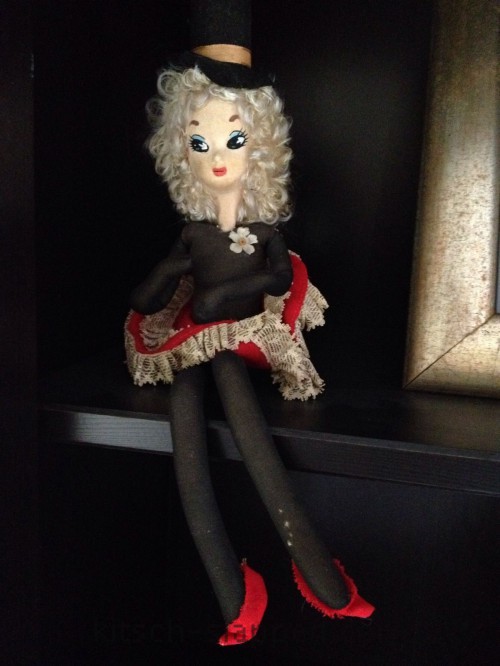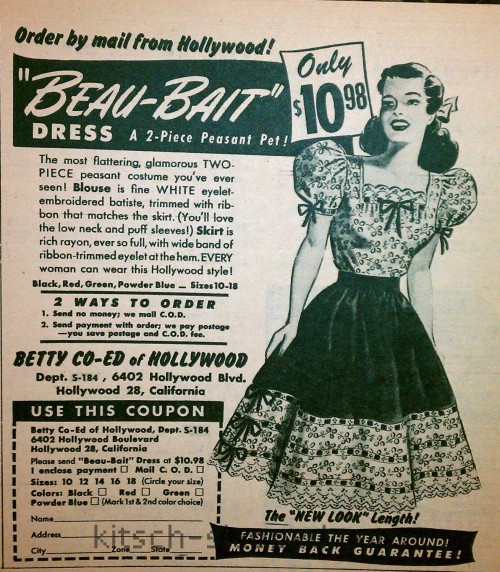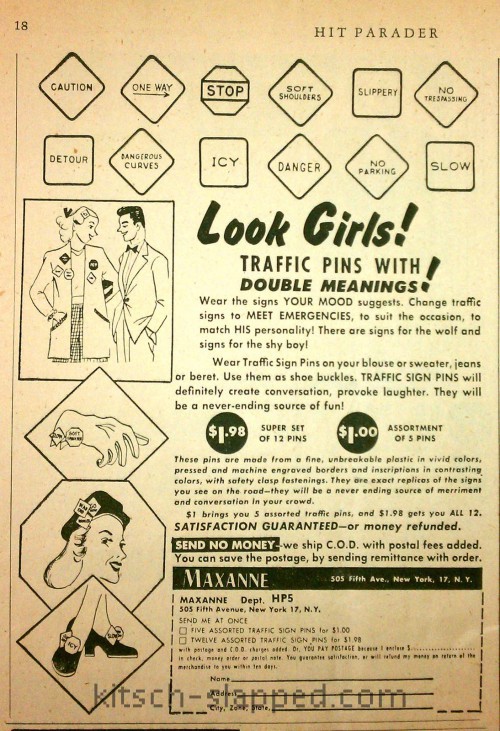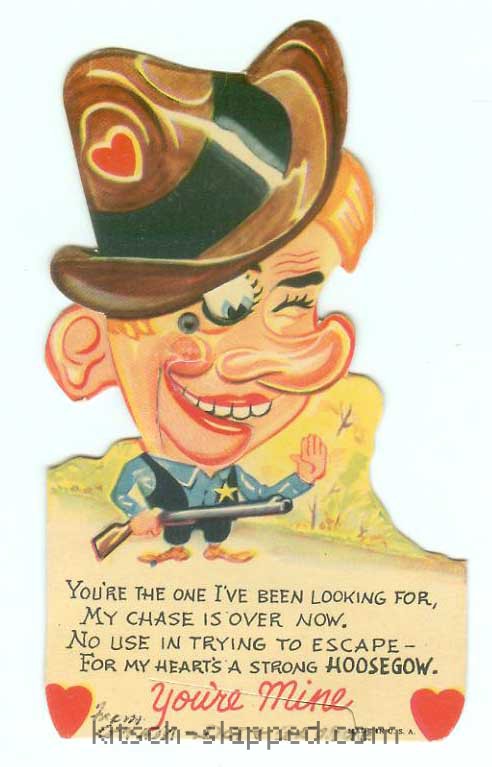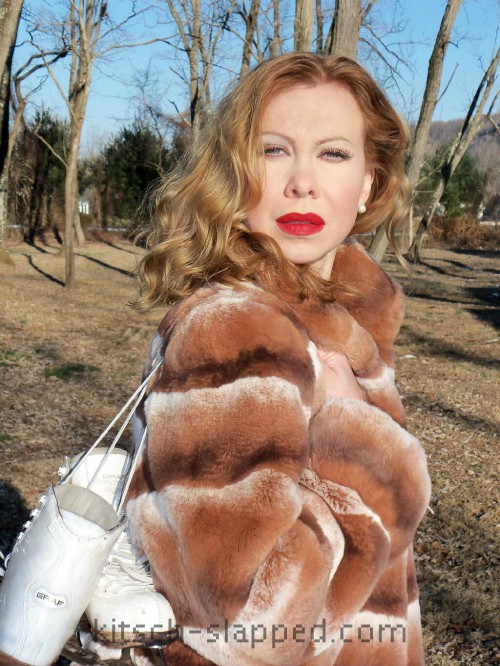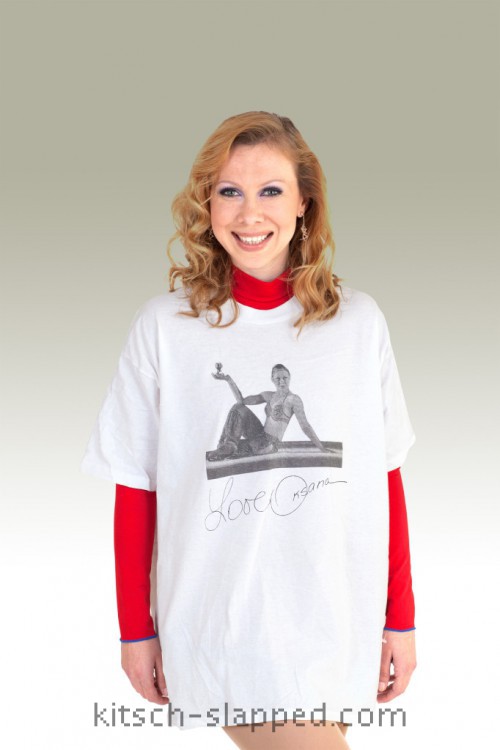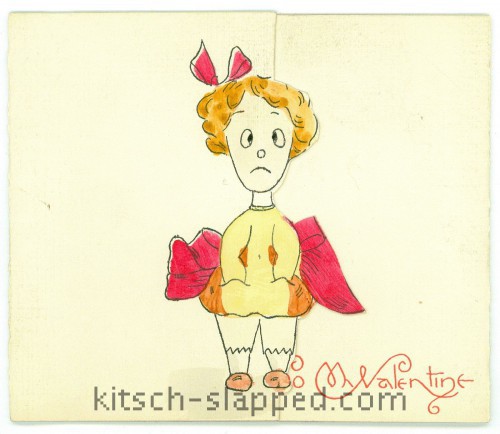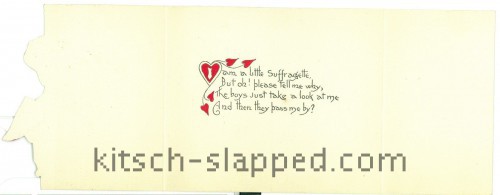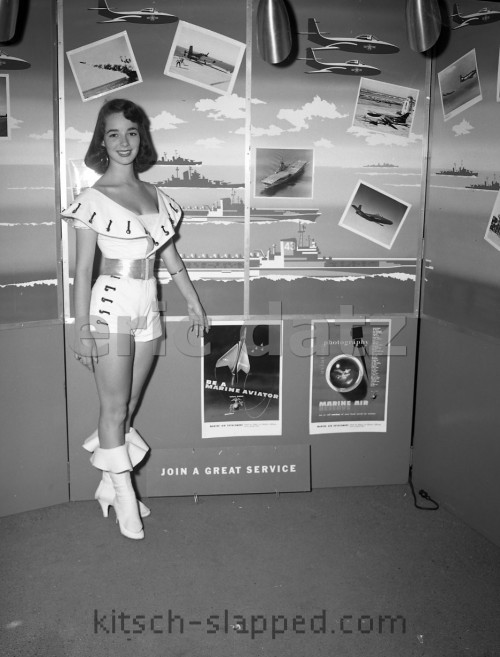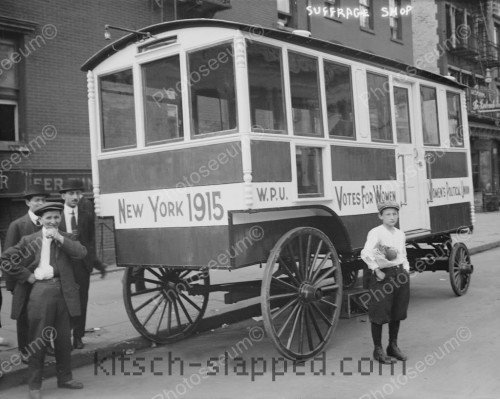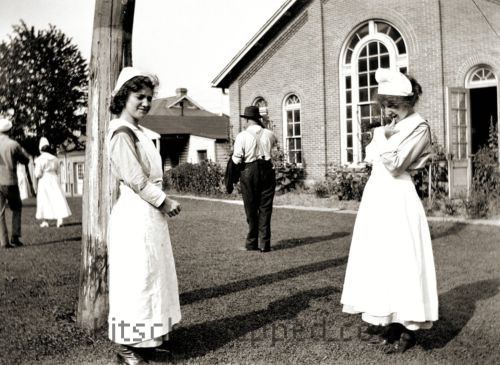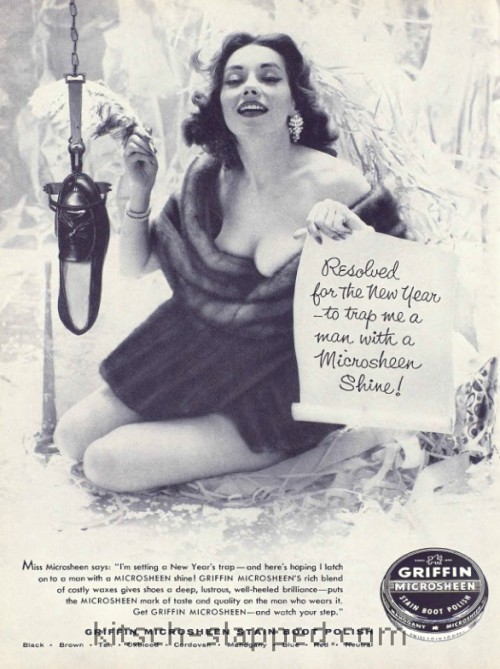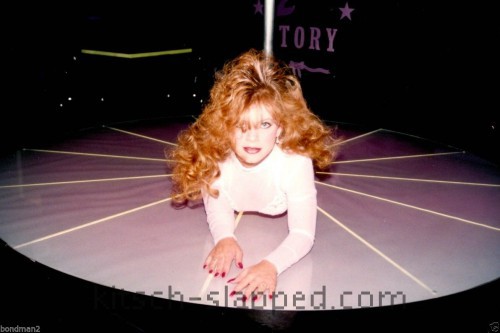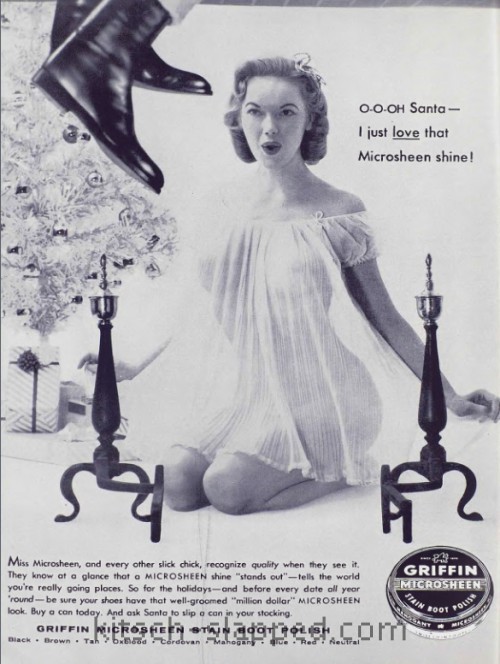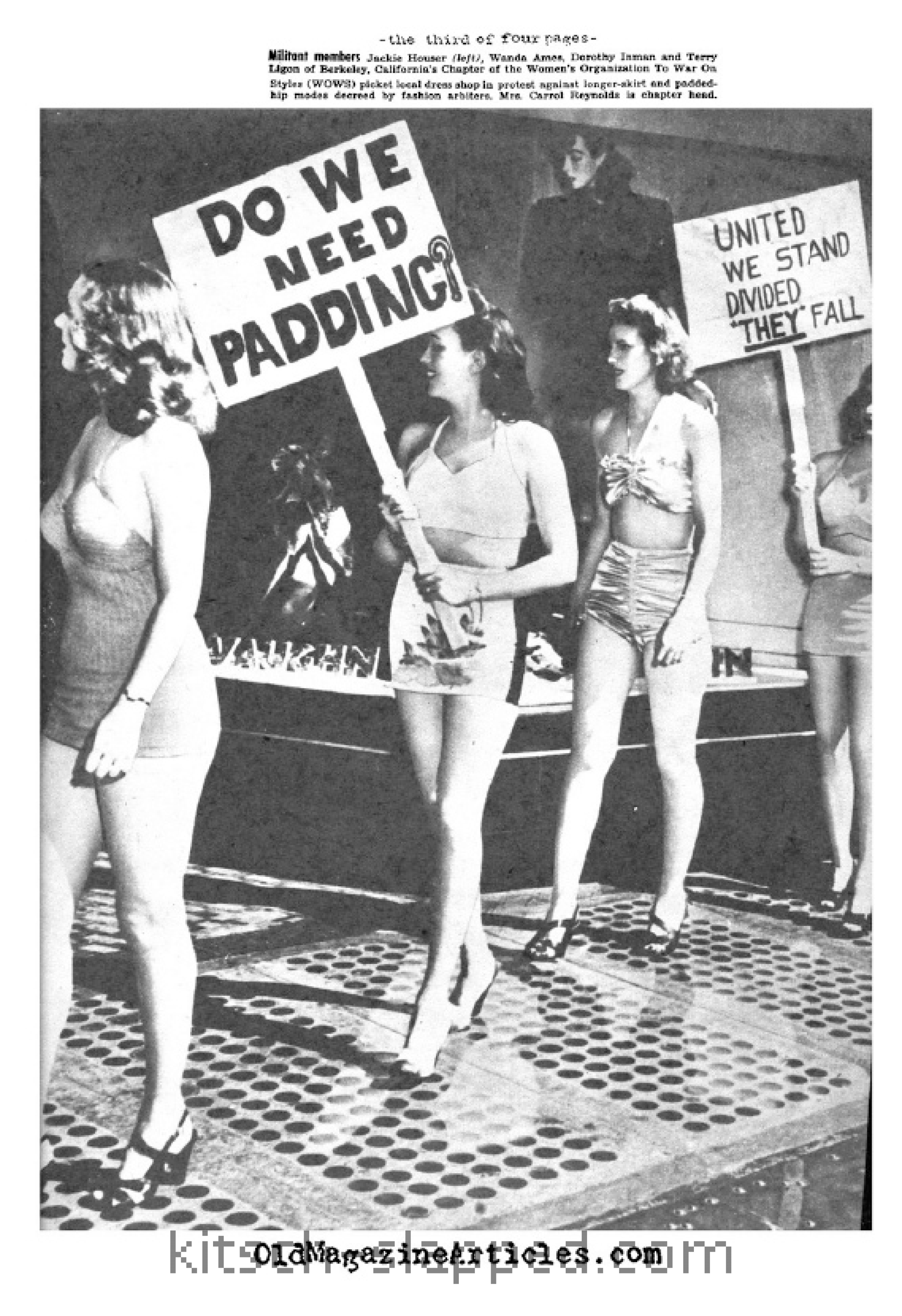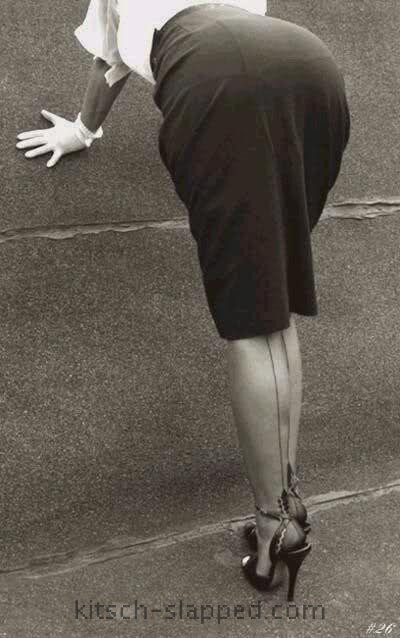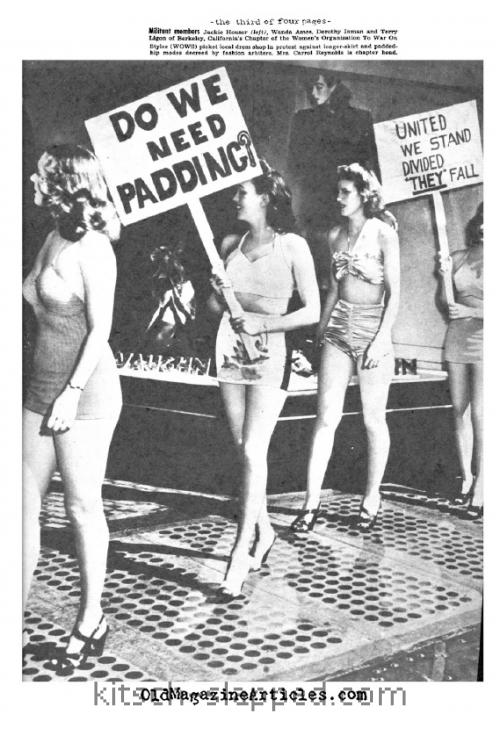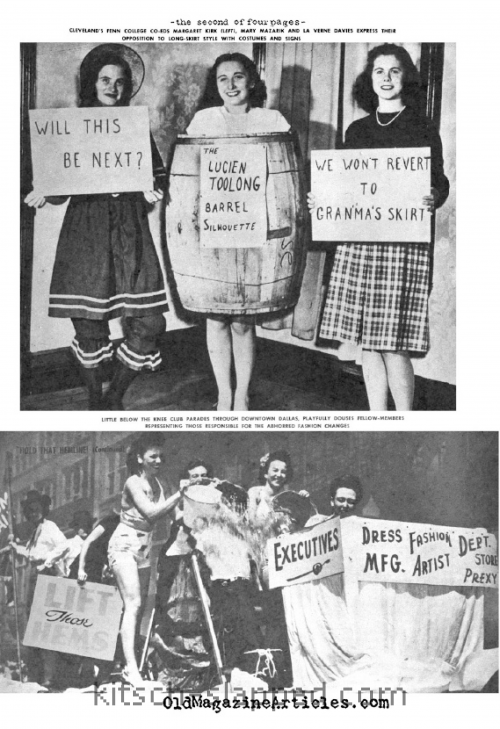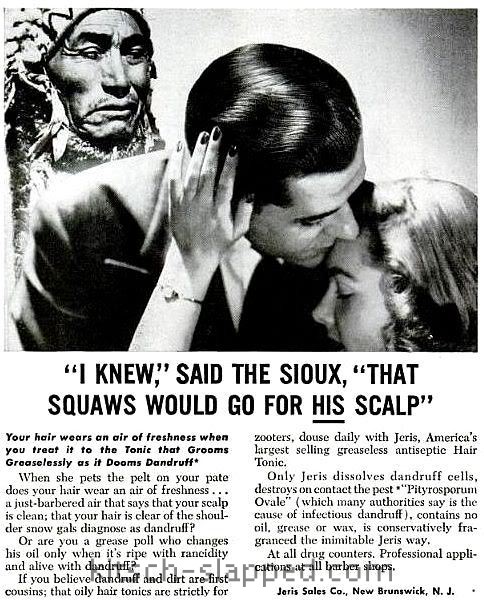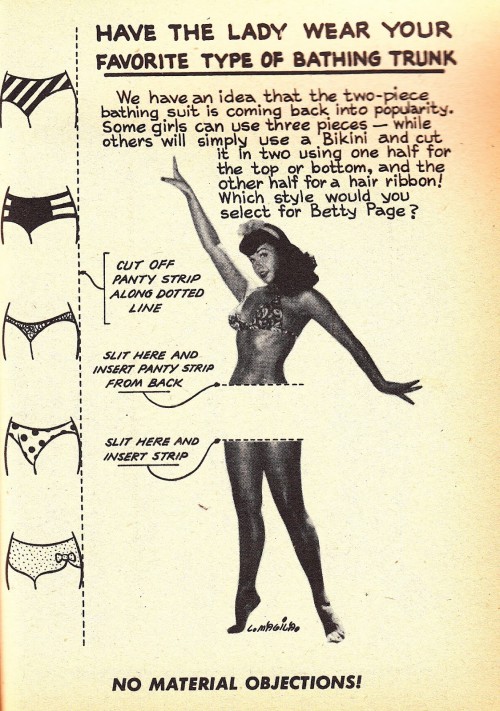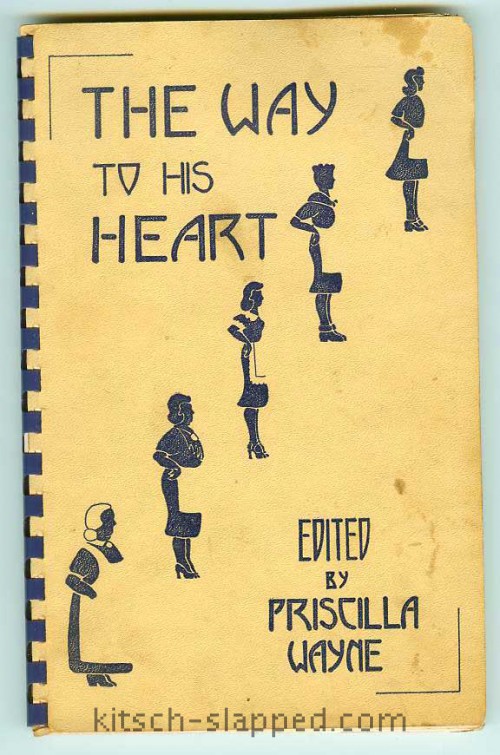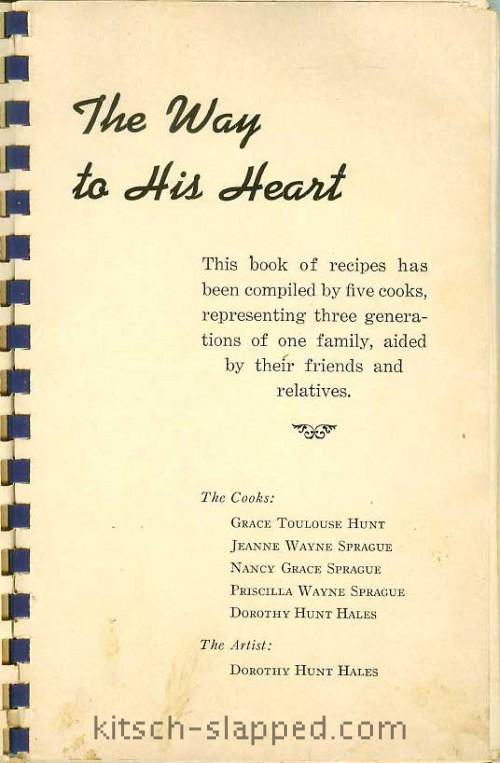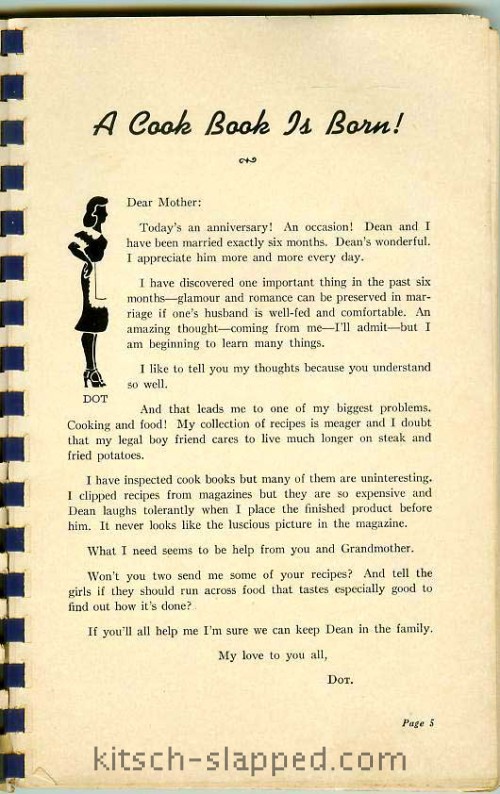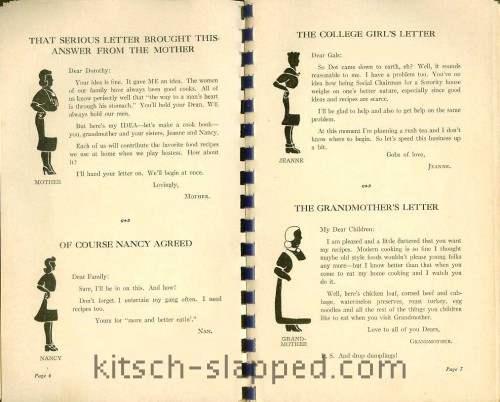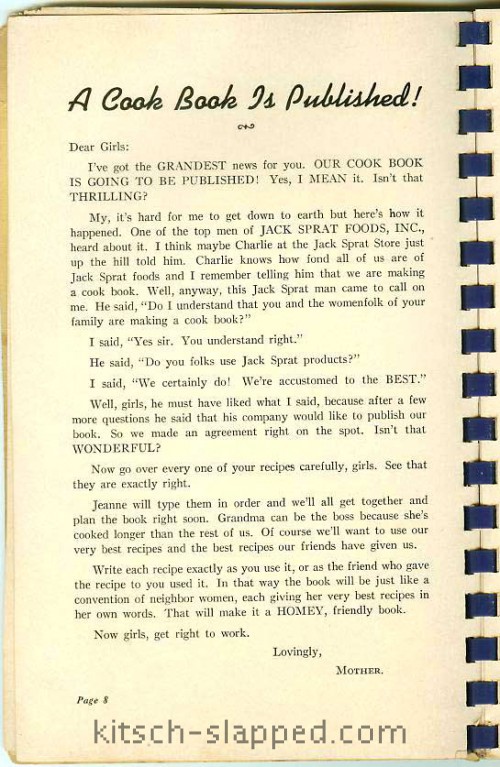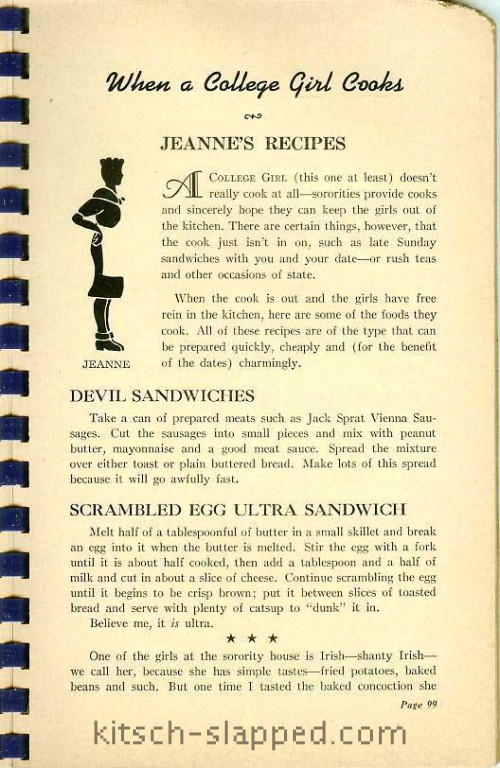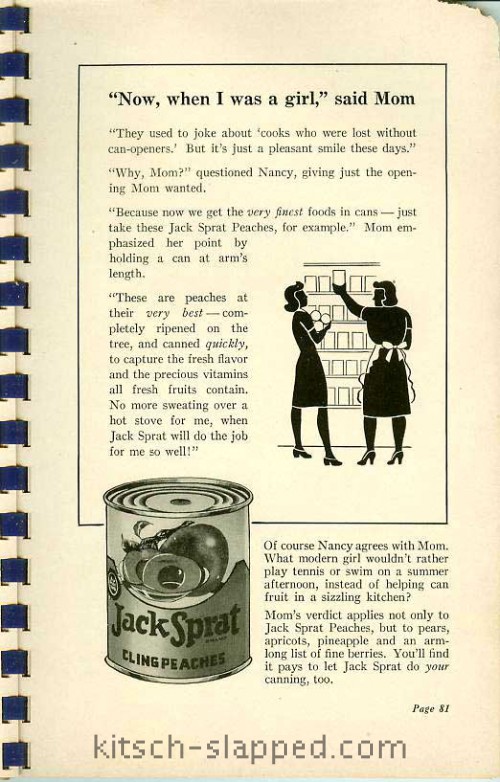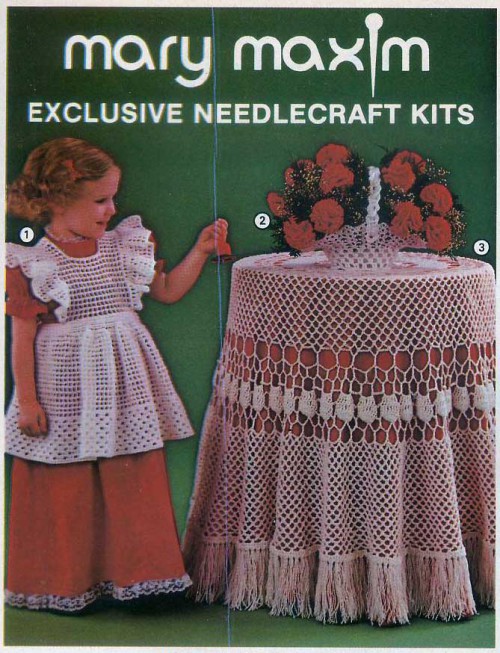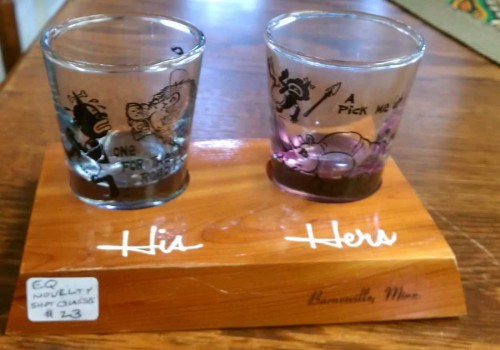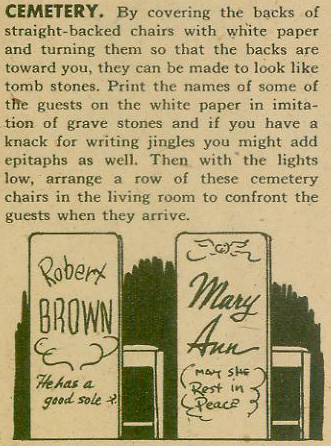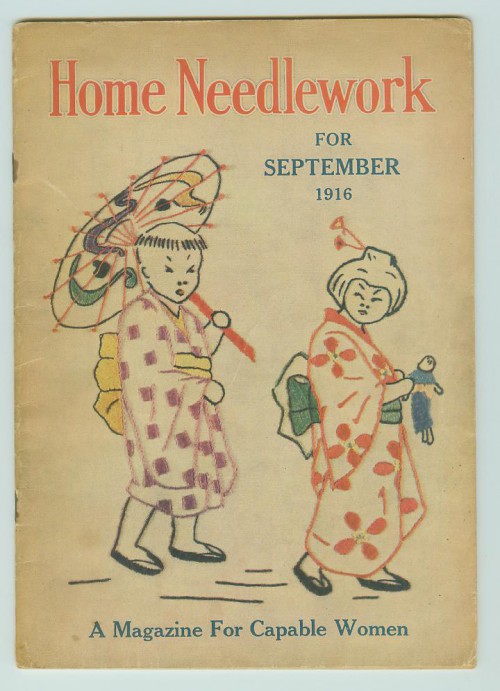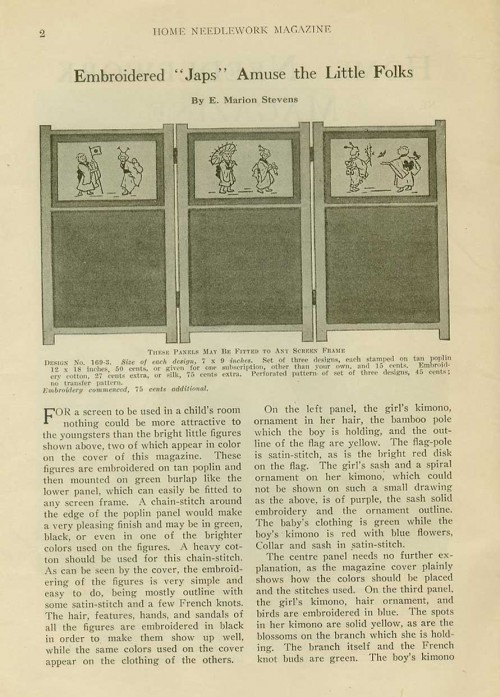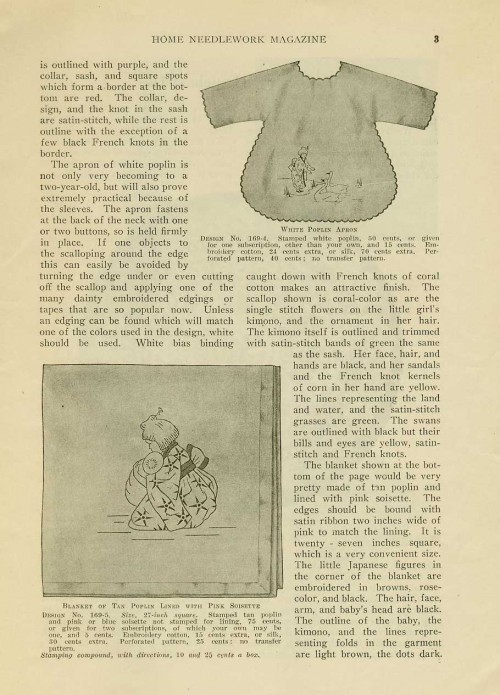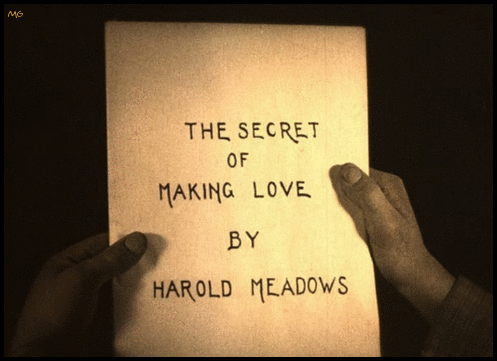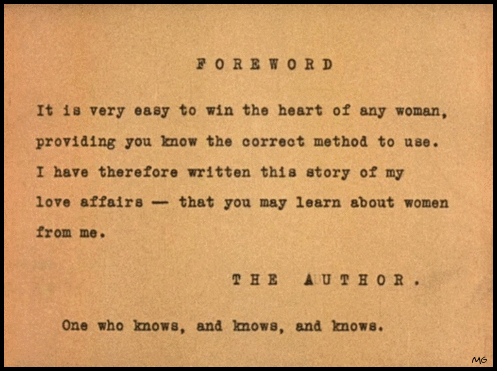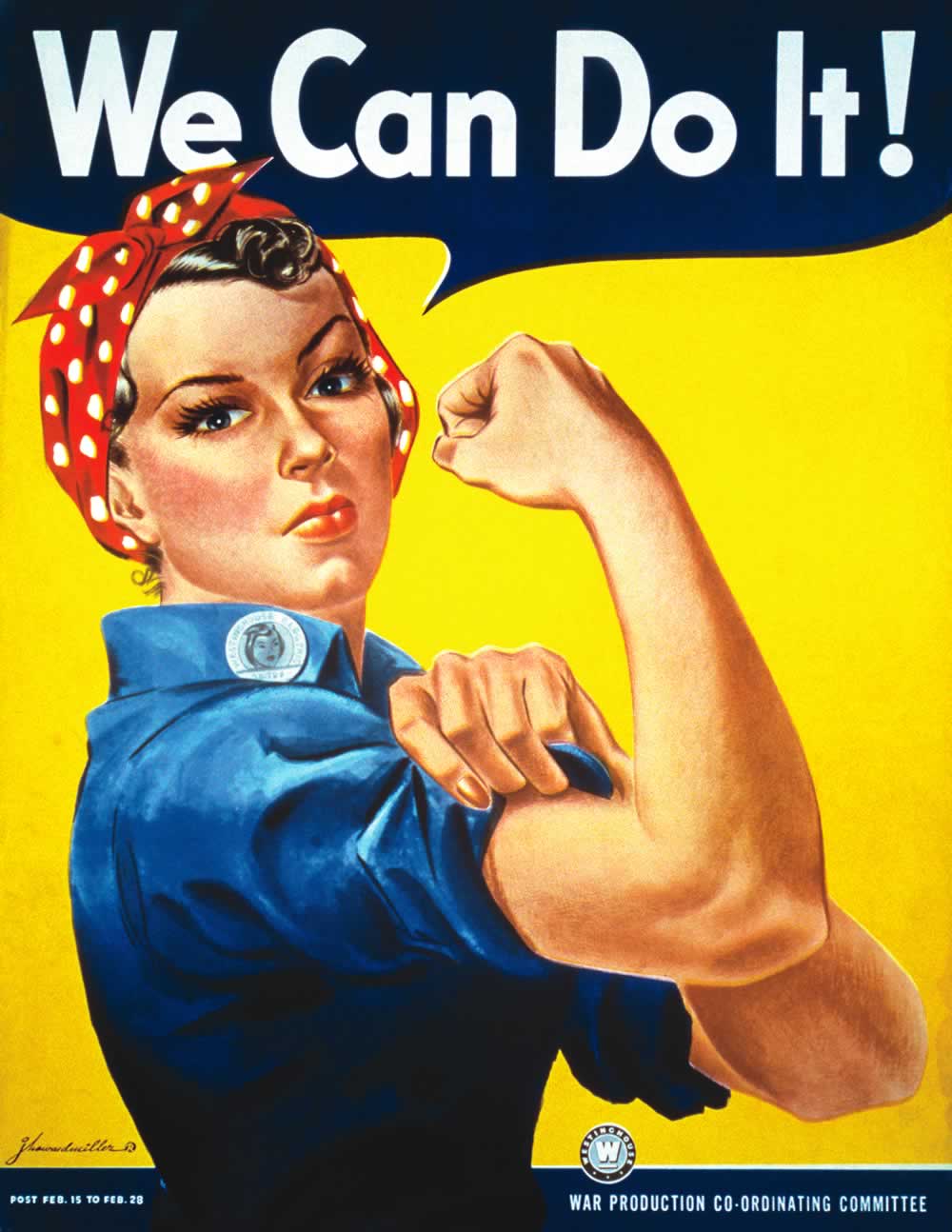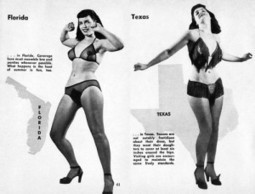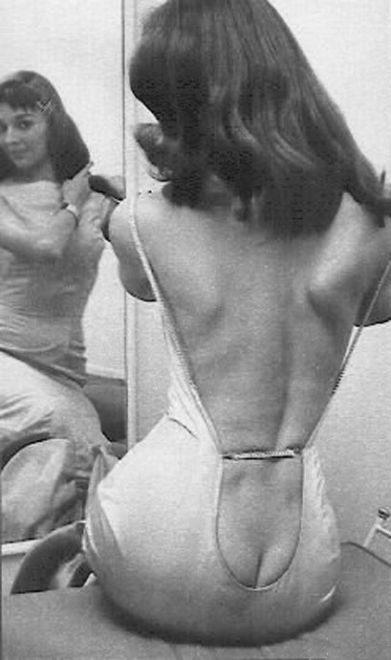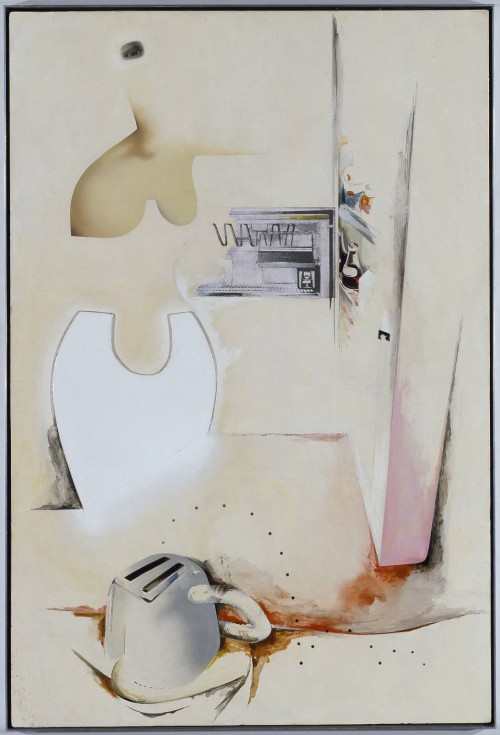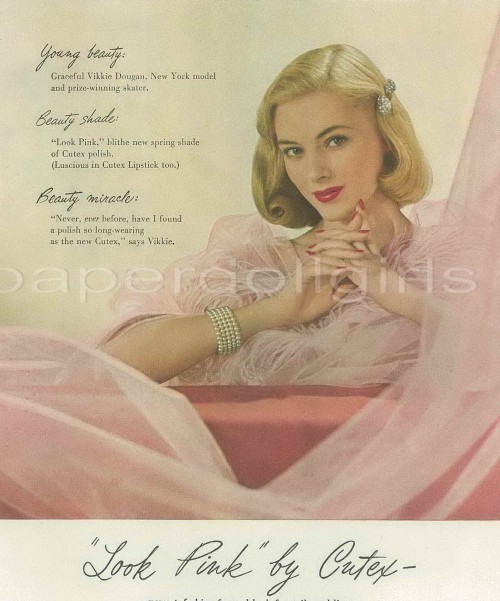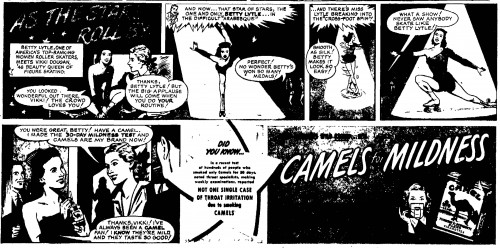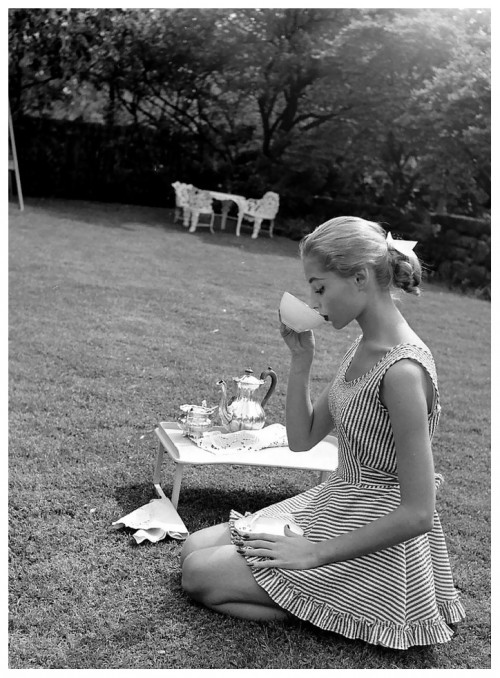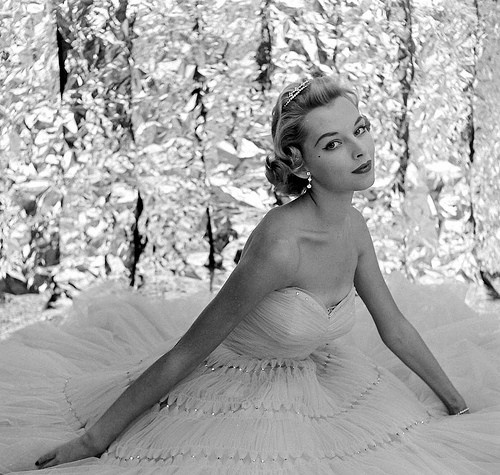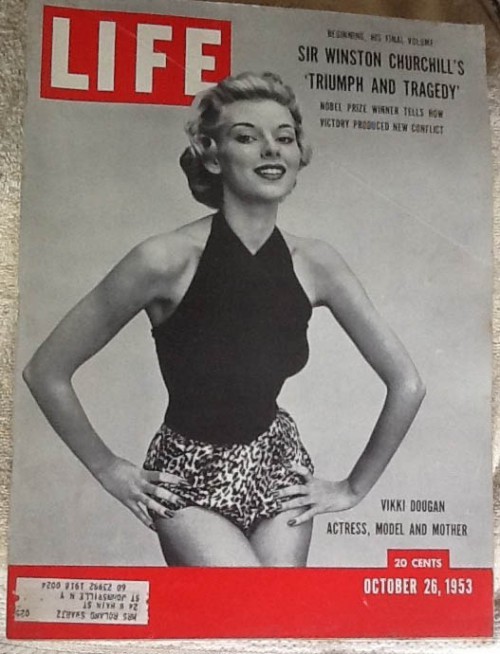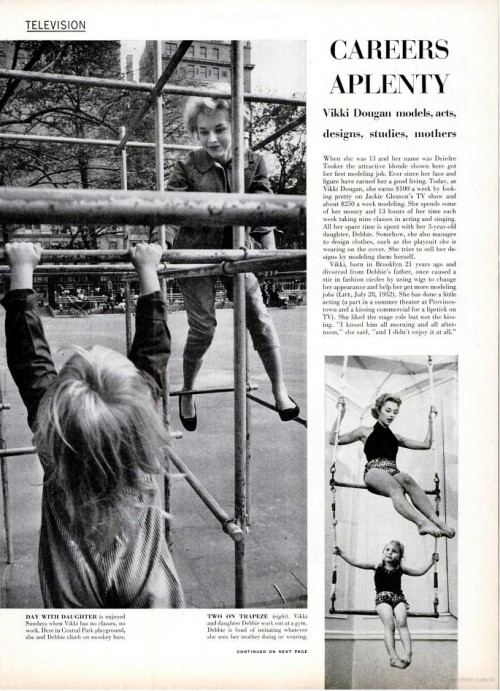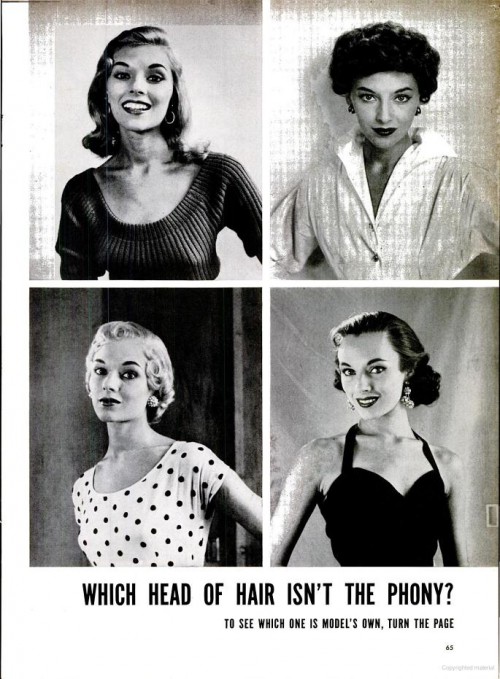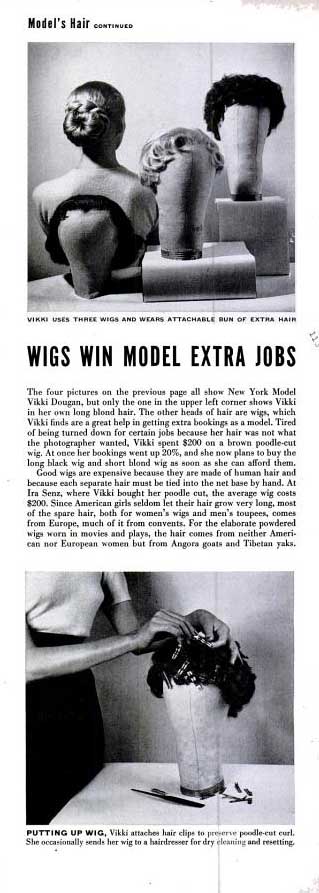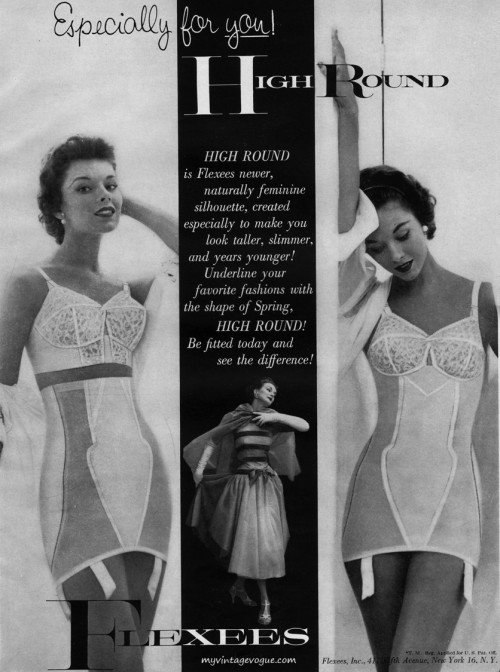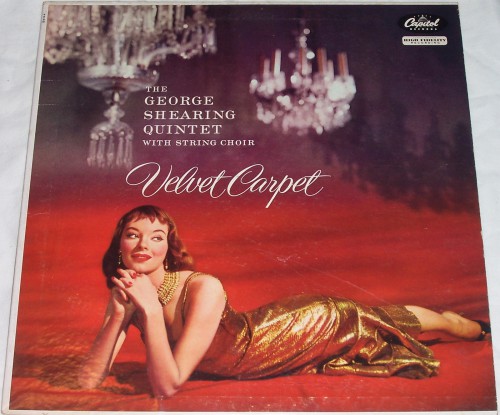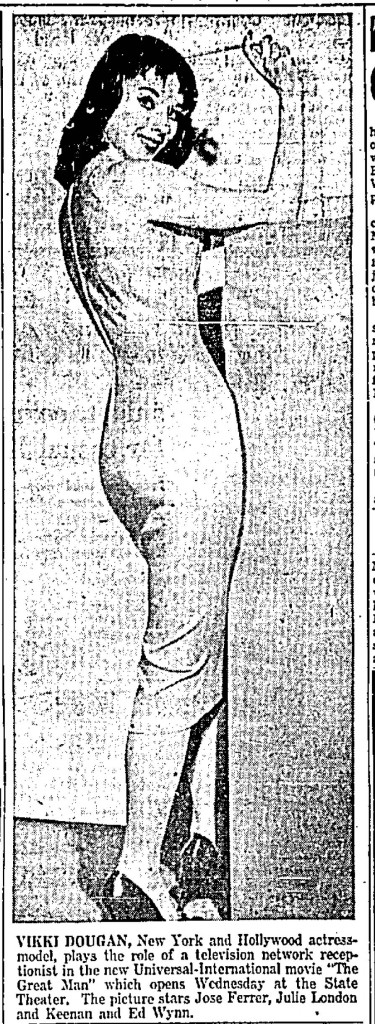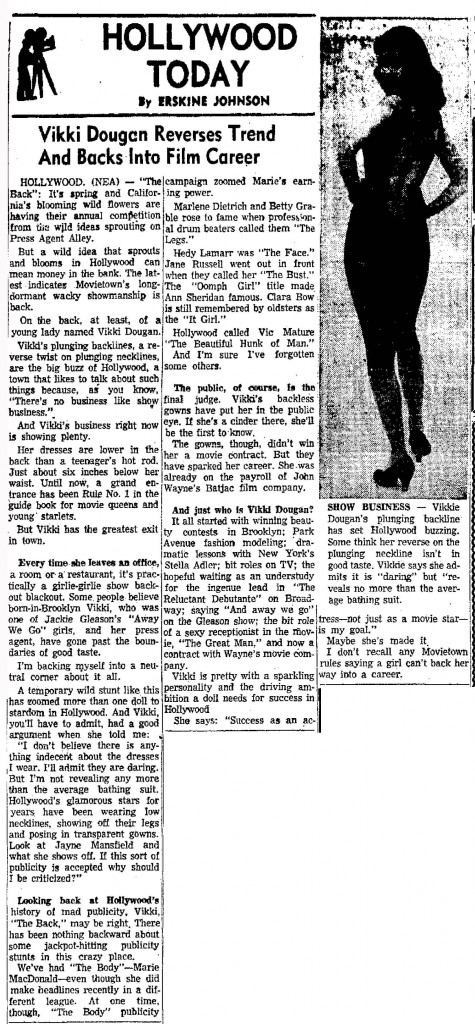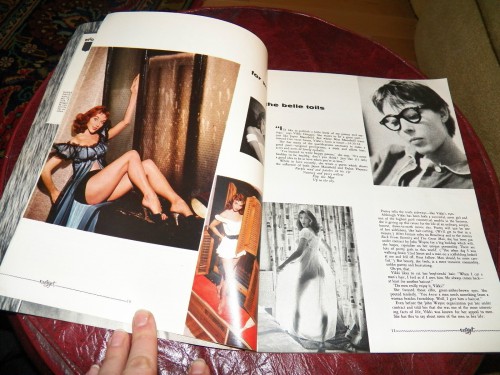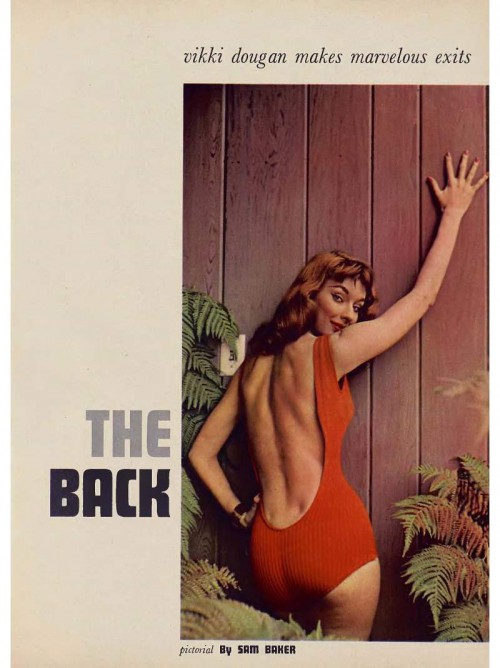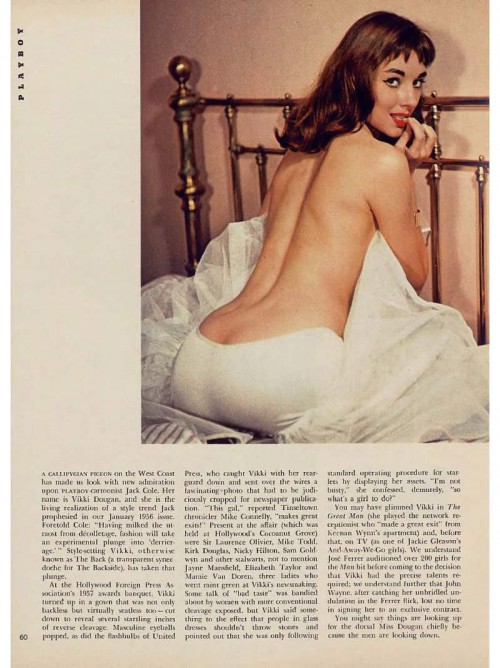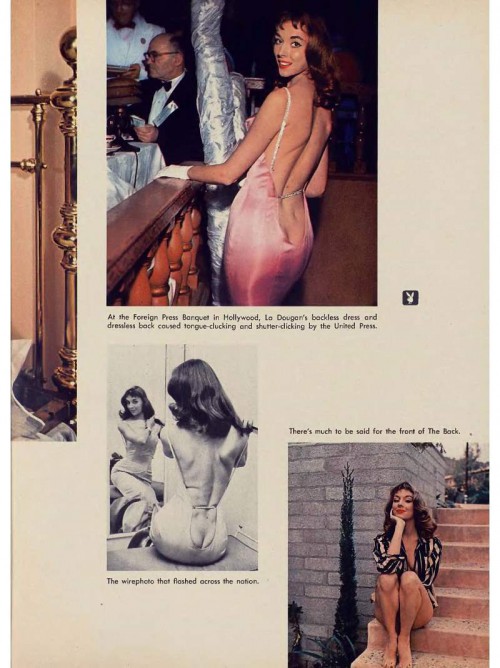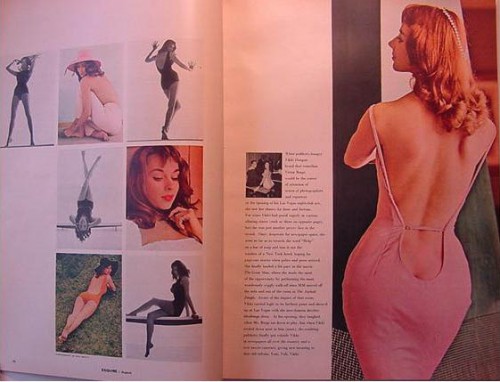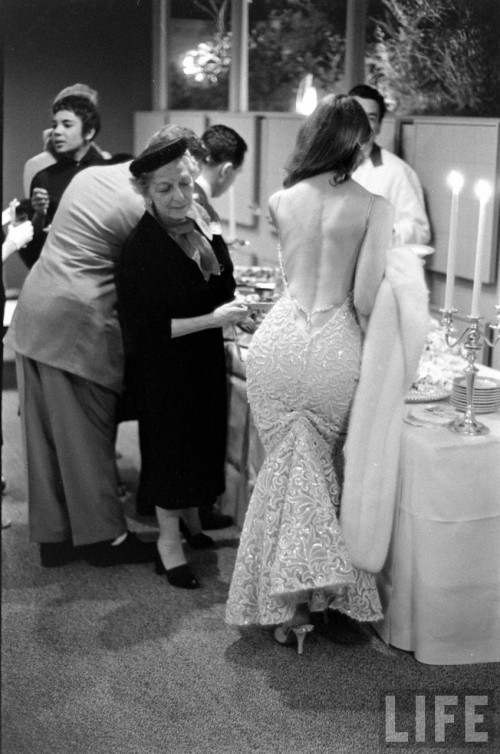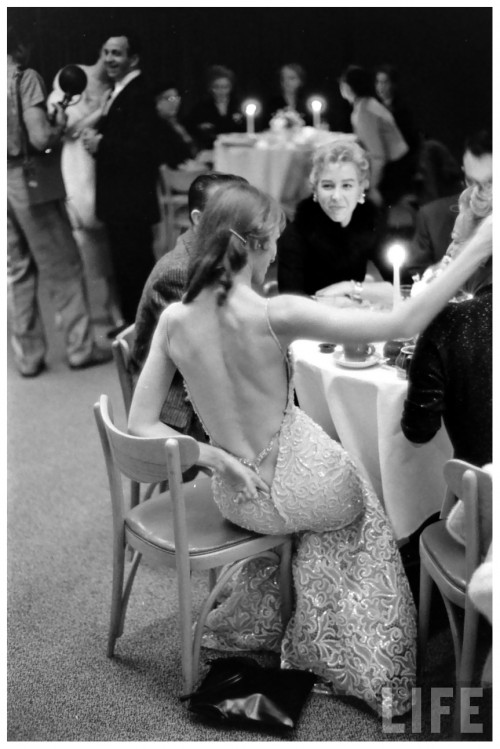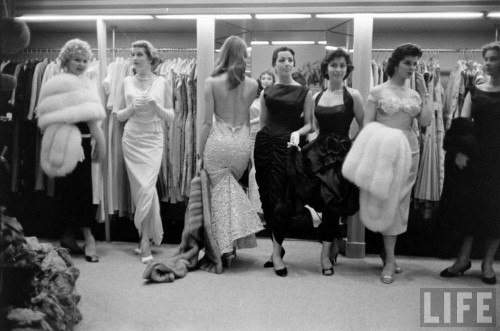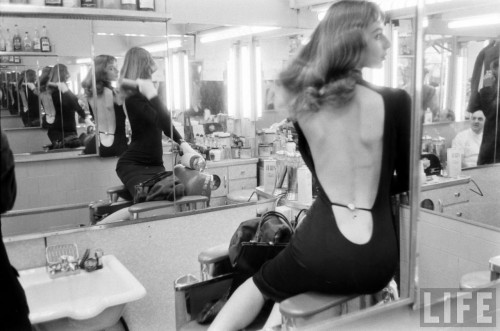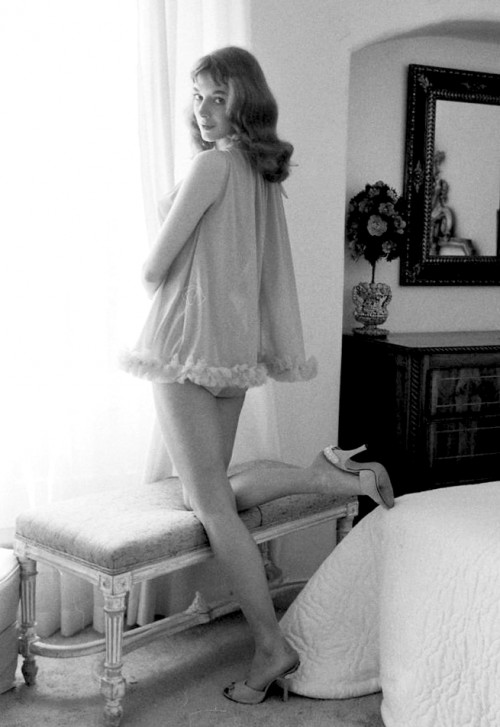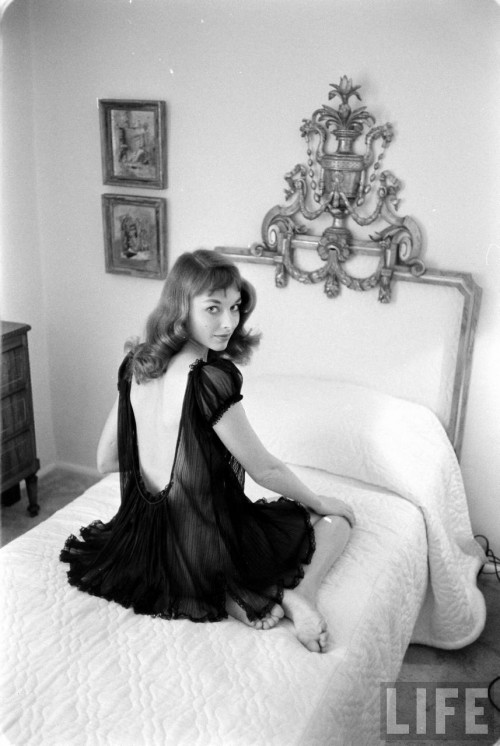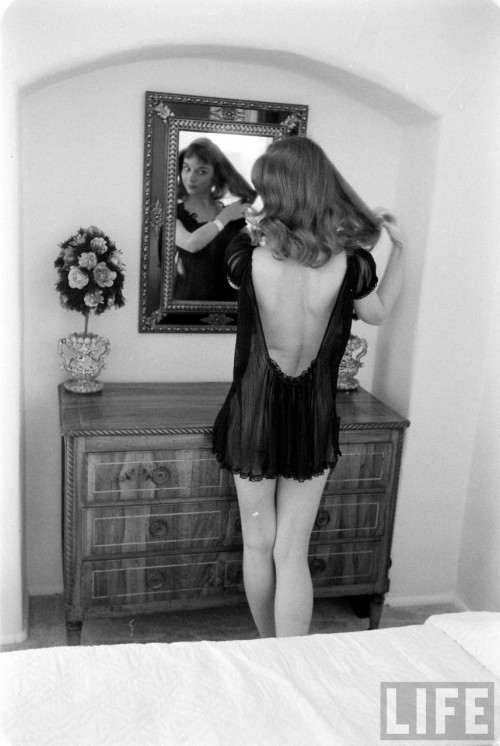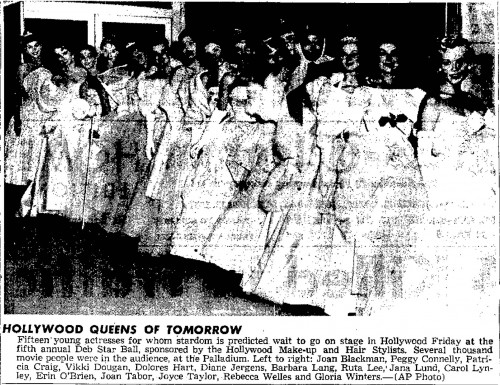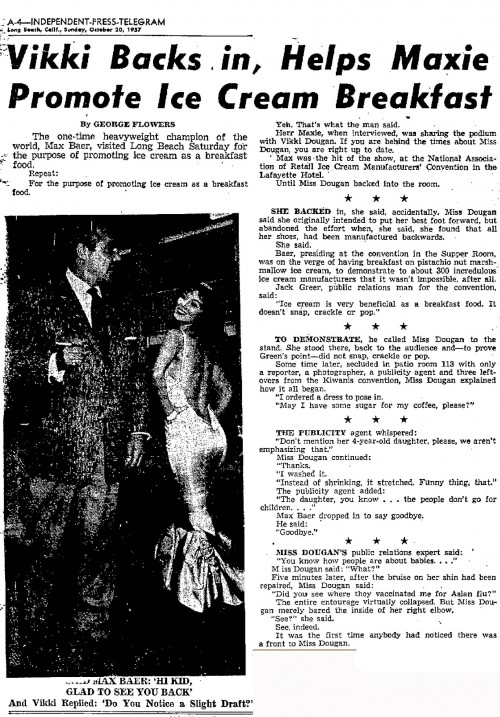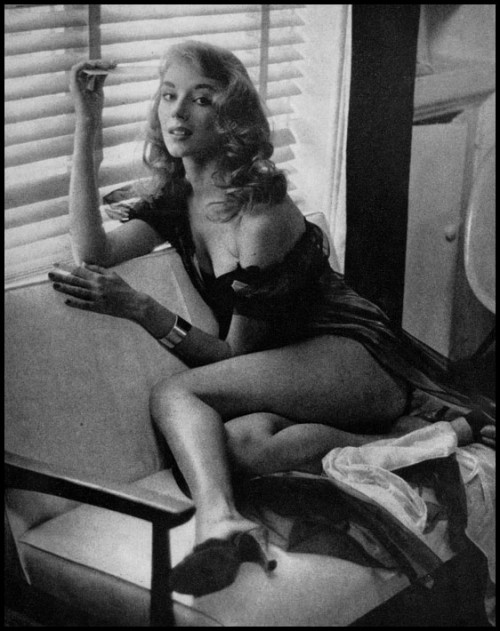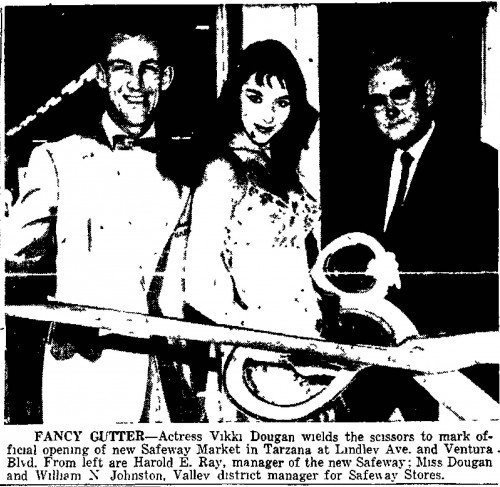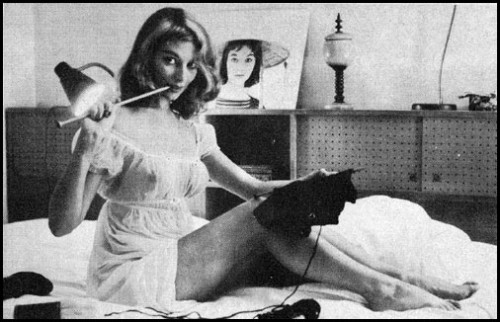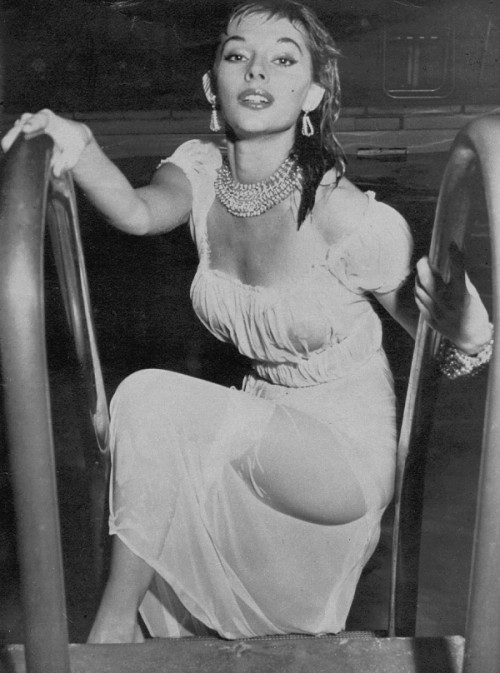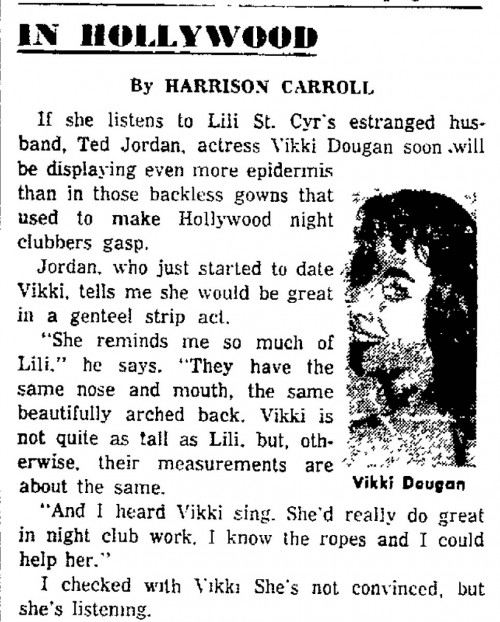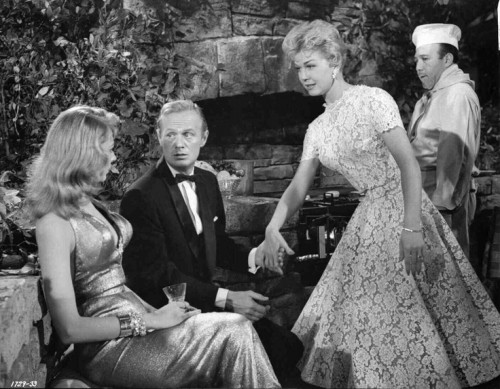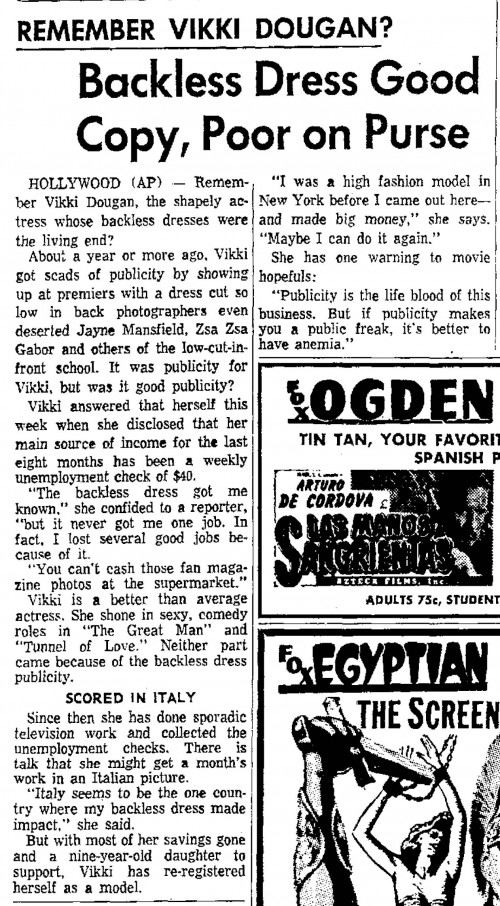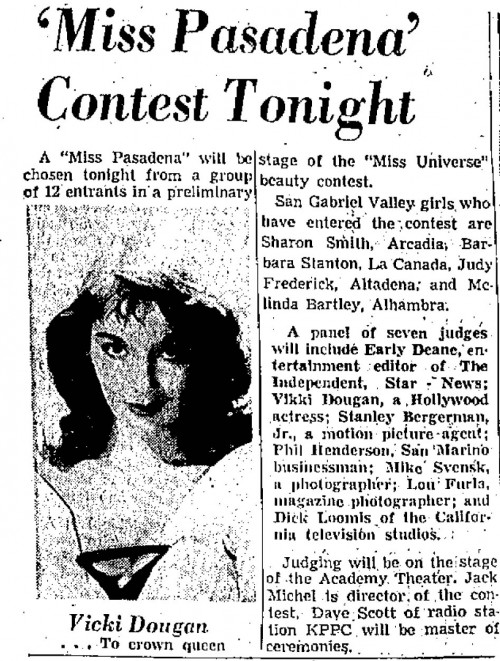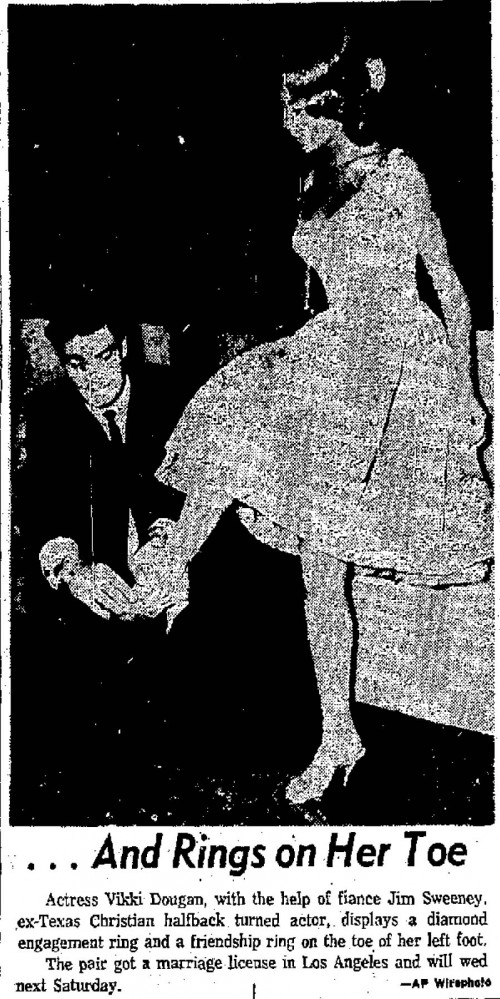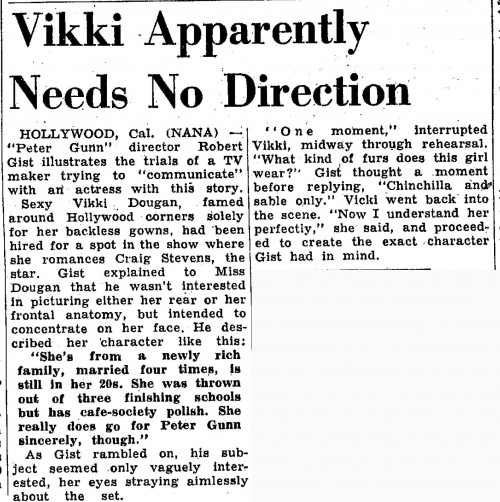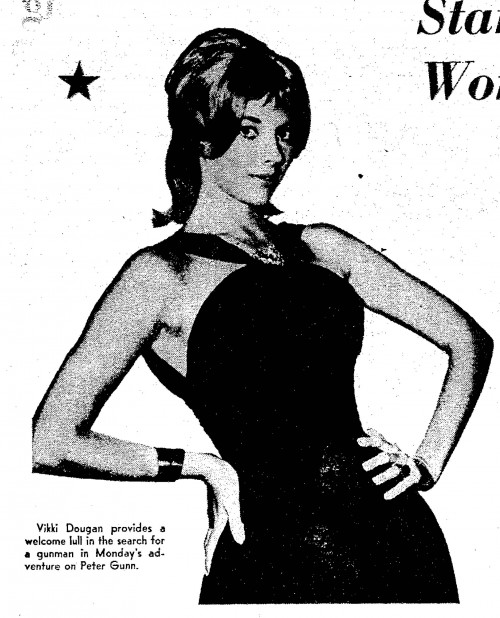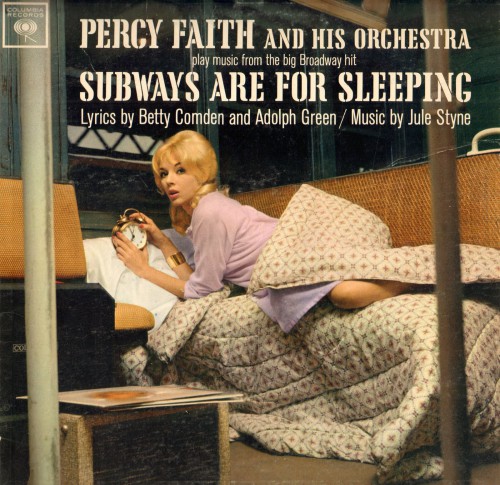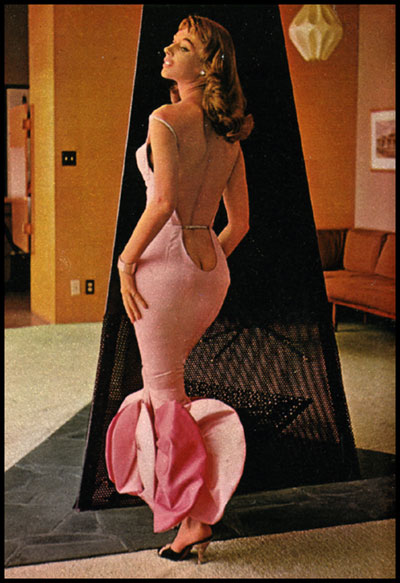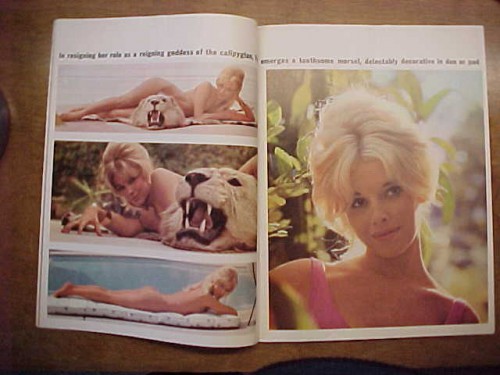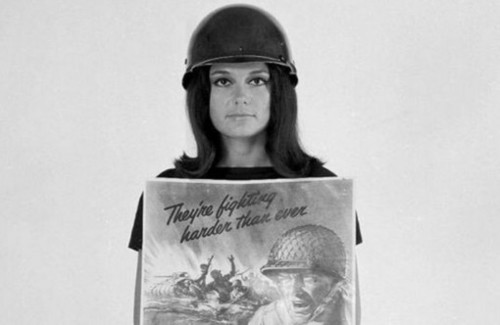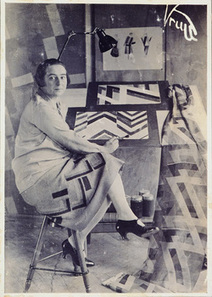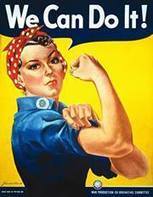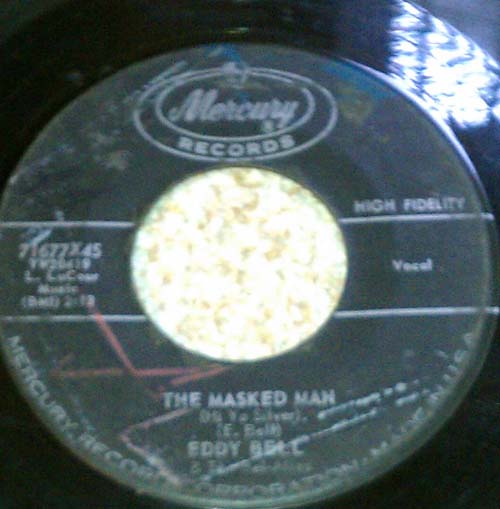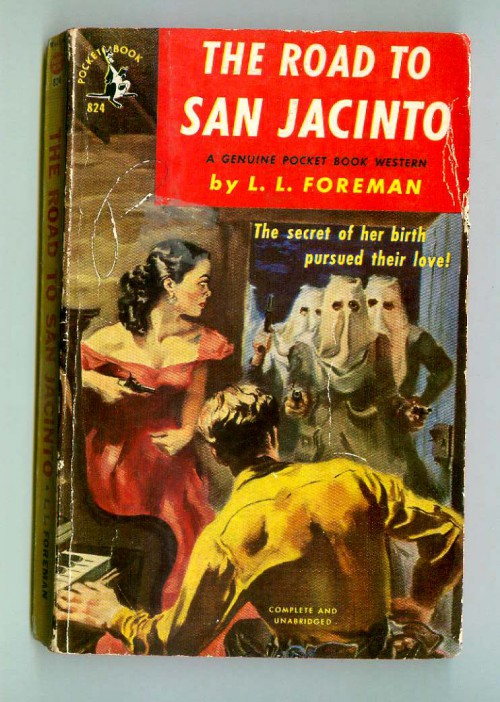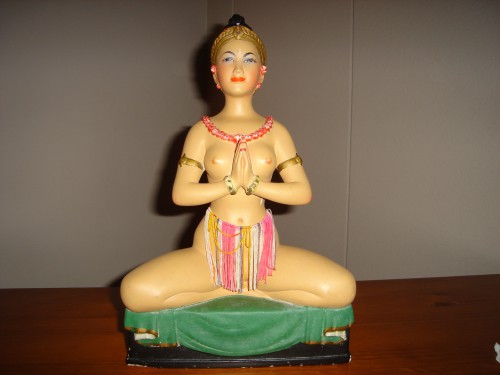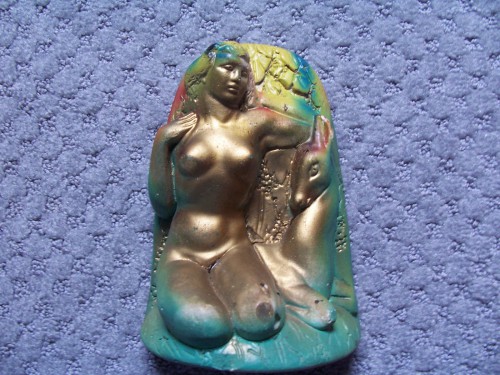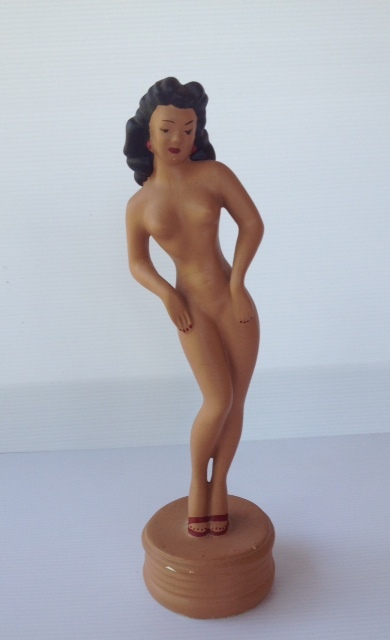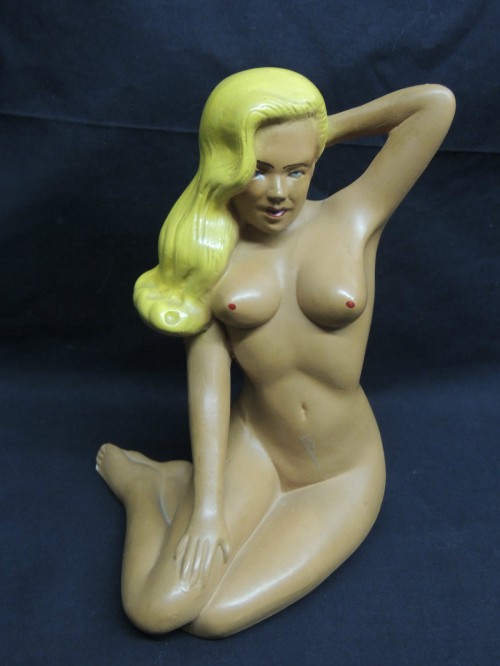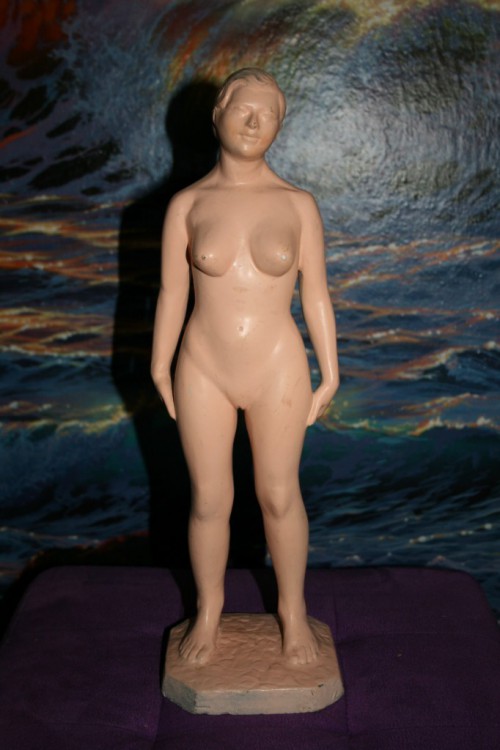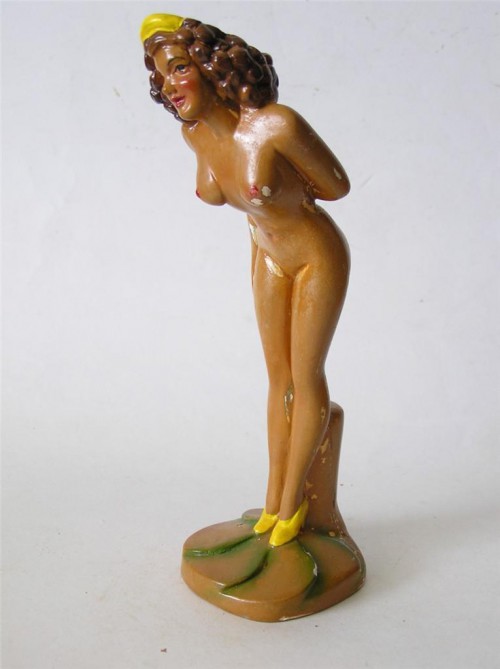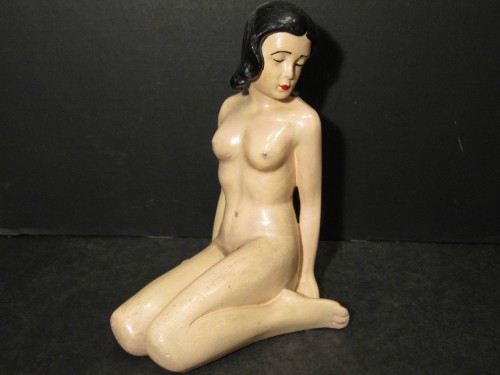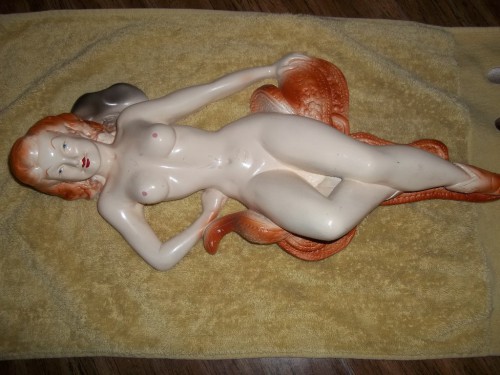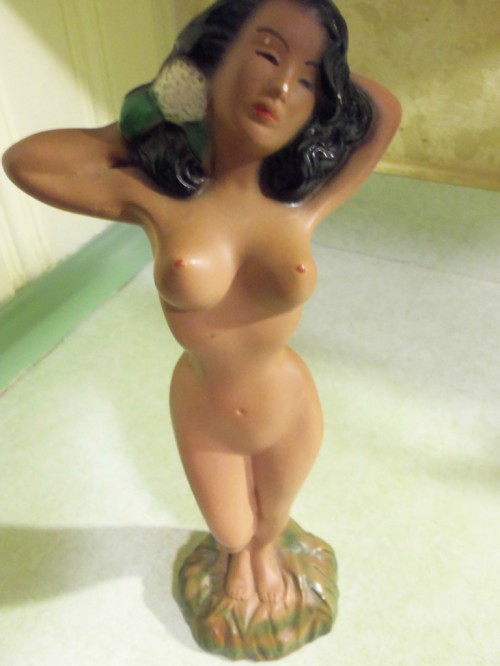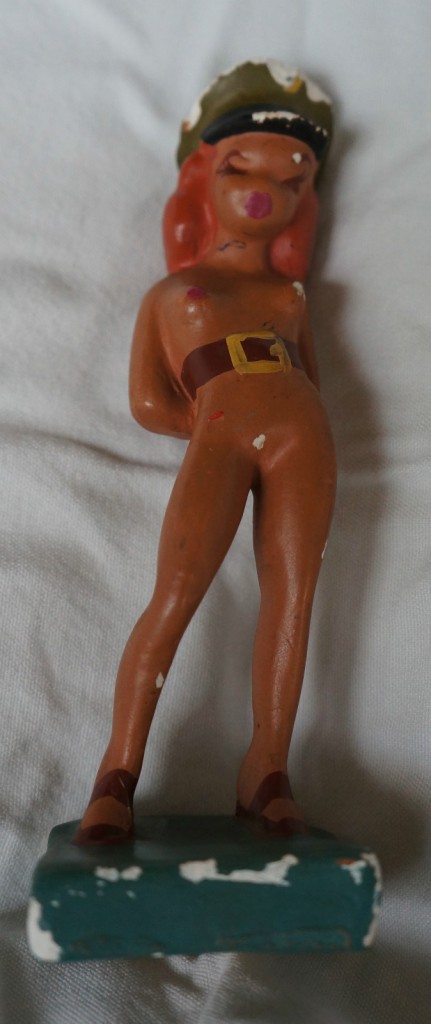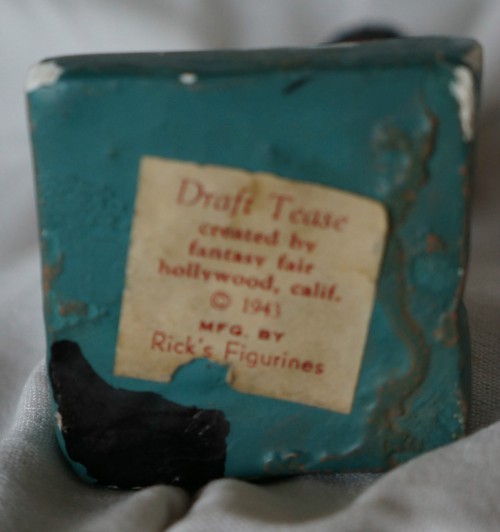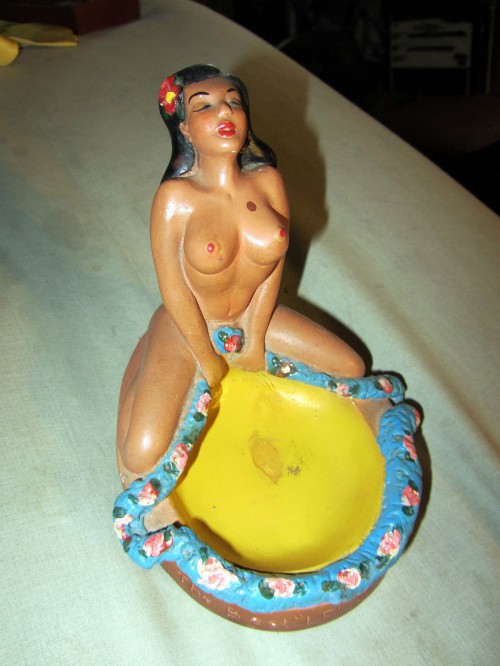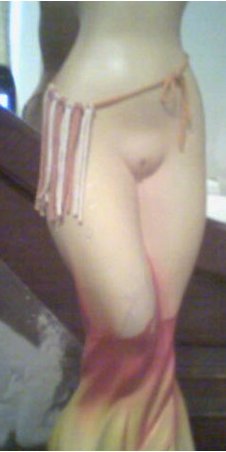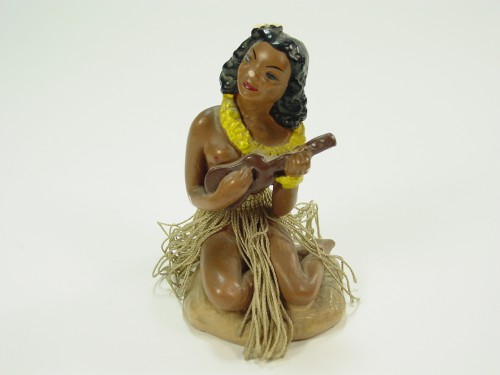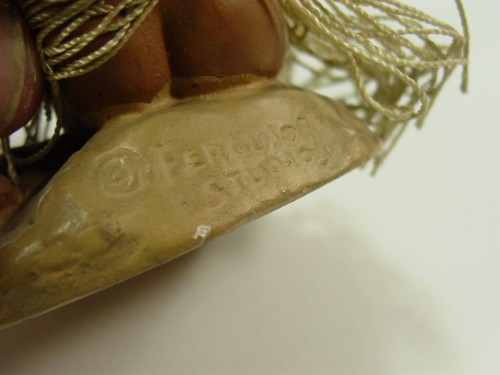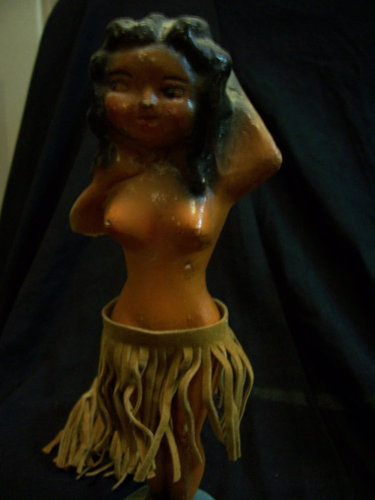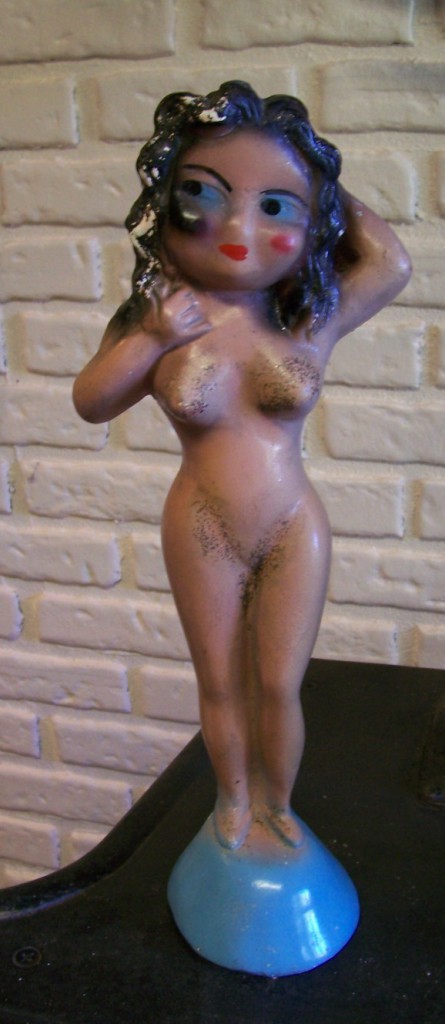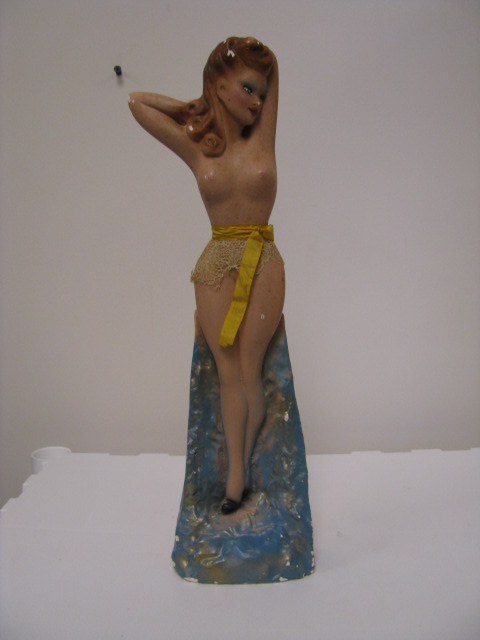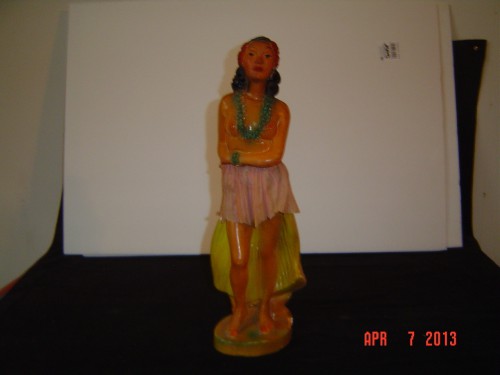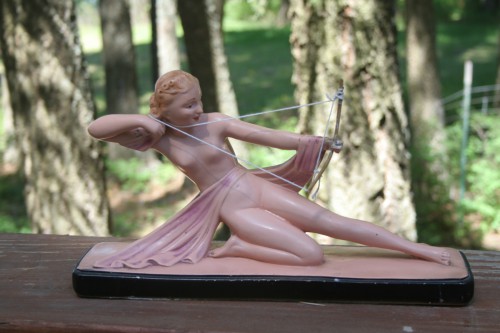Vintage can-can dancer Holiday Fair Doll by Hedaya & Co. NYC, made in Japan. For sale here, from stainedglasssonia.
Tag: vintage
“Beau-Bait”
A two-piece “peasant pet” dress by Betty Co-Ed of Hollywood. Vintage ad found in Sing Magazine, June 1948.
“Look Girls! Traffic Pins With Double Meanings!”
I wish I’d had these back in the clubbing days… Instead, we thought we were clever just saying these old lines.
Vintage ad inside February 1947 issue of Hit Parader magazine.
I’ll Keep You In My Hoosegow, Valentine
Isn’t this a creepy, abusive-stalkery-type valentine? It takes the idea of a prisoner of your love to a whole new (low) level — complete with gun!
You’re the one I’ve been looking for,
My chase is over now.
No use in trying to escape —
For my heart’s a strong Hoosegow.
You’re Mine.
See it in action!
More images of this gem in the My Valentines Have Google Eyes post I made last year at the other blog.
If this is a necessary part of your collection, I’ve got it for sale in our case at Exit 55 Antiques — and they will ship to you. You can call the store between 10 am and 5 pm (central time) at (218) 998-3088 between 10 am and 5 pm (central time) any day. (Yup, the shop is open seven days a week!)
There Will Always Be One Queen Of Ice Skating
For me, the best thing about the Olympics is the figure skating. And nothing & no one in ice skating compares to Oksana Baiul. Into the drama of the 1994 Lillehammer Winter Olympics stole a 16 year old Oksana Baiul, taking the gold and our hearts.
It’s hard to believe it’s been 20 years already…
Baiul is still active (you can like her Facebook page and follow her on Twitter), still glamorous, and she’s celebrating 20 years of Olympic gold with her Oksana Baiul Collection.
Perhaps my favorite performance of Baiul’s, the legendary Arabian performance.
Poor Vintage Suffragette Valentine
Was the suffrage movement the start of “Galentine’s Day”? I can’t imagine this valentine was sent by anything other than a woman to another woman.
Antique valentine via.
Sexism Is In The Air
A pretty pin-up girl pushes the career choice of Marine Aviator. The seller says the photo was taken in the late 1950s at the Los Alamitos Naval Air Station by Don Comoe, the official photographer at Naval Air Station at Los Alamitos, CA.
(See also: Sexism In The Royal Canadian Air Force Fitness Plans?)
Sign Of The Times: 1915
Before feminists fell off the wagon. Reprint photograph of Women’s Suffrage Wagon, via.
Nurse Nice Plays Coy
Photo circa 1920s.
Of Happy New Years & Resolutions
Miss Microsheen is back, confessing her New Year’s resolution to trap a man. As a married woman, I’ve already trapped my man; and now I move on to more practical resolutions, like organizing the house.
Big 80’s Hair
Made sexy by professional exotic dancers. Photo via Lynnstudios.
Merry Miss Microsheen
Is Wearing Vintage Fashions Feminist? (Or, Sign Of The Times 1948)
At my vintage living blog, Things Your Grandmother Knew, I’ve written about the tendency to romanticize the past, but I recently read two blog posts discussing vintage fashion in terms of “the vintage girl being the new feminist” and thought it was time to discuss the subject from a more feminist angle…
At Style High Club, Lena Weber writes:
I don’t quite know how it happened or when but far too many women around me seem to want to look like a porn actress these days. Or why else would they wax off their pubes, slather themselves in Fakebake and state Page Three Girl in their career goals? There is something about the passivity of this particular idea of femininity – there to be stared at, cum onto – that I find deeply infuriating. It’s just sad that we’re all meant to look like little plastic sex dolls – fake eyelashes, fake hair, fake tan, fake boobs.
To my relief (no really, it is!) there is a great big social group of women out there who don’t buy into this image – the vintage girls. Although the vintage scene is splintered into smaller subfractions of particular decades, musical styles, dances and activities, the one thing all these vintage-loving women have in common is their embrace of an altogether different femininity, one that’s individual, one that harks back to a time when glamour was exotic and empowering.
At Retro Chick, Gemma Seager responds with something I was eager to point out:
It’s easy to say that this isn’t new, 1950s Pin Ups weren’t exactly sold on their educational qualifications, and the idea of a woman whose goal was to marry a rich man and live happily ever after is hardly a new concept either. That’s why we had the “bra burning” feminists of the 60s and 70s. They stood up for the rights of women to be whatever they wanted to be.
But then Seager heads right down Weber’s path:
In the last 2 decades the internet has seen a progressive pornification of culture till it seems that women now feel that they can’t assert their own sexual independence, that they have no choice but to buy into this porn star, brainless ideal of female beauty and passive sexuality. They are modern day Stepford Wives, emotionally passive and sexually compliant. Brainwashed by television, magazines and the internet into thinking they can’t make emotional demands and that sexual liberation means always wanting to have sex.
Maybe it’s because I am (I’m pretty sure) at least a decade older than these women, or maybe it’s because I am a history nut who gets obsessed with research, but I’m thinking that these two women (and the majority of those who have commented at their sites) are missing something quite important from all of this. And that something is context.
If we look at “today” and compare it to the past, yes, women’s fashions seem to be much more skimpy. [Until, at least, you notice how a New Look wiggle dress is as fitted as any spandex dress — and realize that beneath that vintage wiggle dress or pencil skirt there’s a whole lot of foundation garments making sure the female figure is as hourglass, smooth, and popping (eye-popping and fabric-testing), and as it can be. More on that later.]
Every generation has declared the next one will be the ruin of fashion, morals, and even civilization. In fact, every decade and fashion trend has resulted in criticism — often for the wearer too. Hemlines went up and dared to show ankles — so women could dare to ride bikes! That may seem antiquated to us now, so let’s look at the styles and decades that most vintage fashionistas wear, such as New Look and Mod.
When New Look fashions hit the market, they were not applauded. In Popularizing Haute Couture: Acceptance and Resistance to the New Look in the Post-1945 United States (Americanist: Warsaw Journal for the Study of the United States; October 2007, Vol. 24, p143), Sylwia Kuzma writes:
The New Look promoted a vision of femininity, epitomized in a full-bosom-and-curvaceously-hipped hourglass figure, dressed in lace, fur, and diamonds. Despite the patronage of large New York and San Francisco department stores, it’s reception by the American public was far from unanimous fascination and acceptance.
Some found the look too decadent to be seemly. Some were incensed that Dior’s New Look would require them to be padded. Others found the below-the-knee hemlines frumpy. (Images from a 1948 magazine via.)
A decade later, when the first babydoll nighties and dresses hit the scene, many found them obscene.
The point is, with every hemline, waistline, and neckline movement tongues go a-waggin’.
Today, Bettie Page is held up as a prime example of a cheeky risque pinup to be emulated and adored. She is such an icon for vintage fashion lovers, that many stores, designers, brands, websites, and events use the name Bettie to garner attention. But she’s The Notorious Bettie Page for a reason — her pinup photos were the subject of censorship and she herself was a target of a US Senate pornography investigation. The adoration of Bettie Page as “cute” and “classy” raises the ire of many, including sex workers — many of whom already feel shunned by feminism. To many, this co-opting of Page for “good girls” is a theft they won’t stand for.
Which brings us to the matter of vintage glamour being “exotic and empowering”…
Those are the very words many use to describe their sex work and to defend a sex positive or even “pornified” culture. In many ways, today’s sex workers and pornified pop culture icons control their bodies far more than the women of decades ago. The 1950’s woman put on an exaggerated-hourglass Dior dress to lure in Mr. Right for marriage. Once she “caught” her man, she put on a golden wiggle dress to serve cocktails to her husband’s boss; a pretty little prop in her husband’s life. When The Little Woman needed to be medicated in order to endure her life, her doctor talked to her husband-daddy, so he could make the decisions for her — as if she were a child. Does that seem glamorous, exotic, or empowering?
Wearing vintage fashions may be moving the hemlines, waistlines, and necklines back in time, but does that move women forward towards equality?
Yes, fashion sends messages about who we are — at least at that moment. But, ultimately, what defines a person is their actions. And if we start labeling and denigrating people for what they are wearing, then we are on a very slippery slope . This is especially true for women because of that whole “what she’s wearing is asking for rape” thing. Not to mention that whole “what does a feminist look like” argument that no body wins.
Our bodies belong to ourselves. We’ll dress them ourselves, to please ourselves, and we’ll be the kind of person we wish to be.
Bad Hair Is No Joke (Or, Hairy Situations In Racism & Misogyny)
I have not been doing a lot of “link round-up” posts since I’ve been curating at Scoop.it, but sometimes I will still find a thing or two which will spawn so many quick thoughts that it seems best to fire all the rounds in one quick-draw post. That’s certainly the case today as one vintage image and one blog post have me quickly shooting from the hip.
Via this post at Doc Blue’s Bullshit Emporium, I found this vintage ad for Jeris Hair Tonic at Retro Adverto. Along with the horrid ad copy, there’s the racist and gender obscene headline:
“I Knew,” Said The Sioux, “That Squaws Would Go For His Scalp”
I don’t know that I actually have to beat all the dead horses in this vintage ad, do I? With so much horribleness going on, it’s hard to imagine that Jeris would survive; but the company — and it’s hair tonic — is still around today. I do hope they die a little on the inside whenever this ad is resurrected.
While we are on the subject of hair…
Lip Mag has a piece on hair: crowning glory: hair, sex and gender. My profound dislike for the absence of capitals in headlines aside, the post is rather provocative and worthy of a good read. However, it is a bit incomplete. I don’t think it is proper to discuss or rant about such things as “long and blonde” being the ideal femininity standards for women’s hair without pointing out that there are some biological reasons for this.
Often, “beauty” is really just about genetics, healthy children, and the survival of the species. Long hair is a sign of health, and health is genetically preferred. Lighter hair, especially blonde hair, is often an indicator of youth and therefore fertility. The fair skin which typically, naturally, accompanies the blonde hair also makes it easier to see signs of disease, infestation, infection, and the like. Such blemishes are signs of genetic weakness, aging, or other potential problems with the viability of offspring. This is all hardwired into humans biologically. It’s primal evolution. This is why fake blondes enjoy the same attention as natural blondes; for even when everyone knows they’re seeing a bleach-bottle-blonde, the sight triggers an unconscious response of, “Yes, this is preferred genetic material.” This biological drive is what is sets many “beauty standards”. And since blondes, especially the light-white-skinned and blue-eyed variety, are fewer in numbers, their rarity is akin to “coveted and collectible”. [After decades of hair styles, lengths, and colors I know (NWS) that blondes do have more fun — if by “fun” you mean “attention.” Not all of it positive, either; especially when the attention is from other women (NWS). Women hating or deriding blondes, real or fake, is like any other body shaming issue and should be stopped.]
While genetics and evolution are typically not conscious thoughts in the process of calling someone “beautiful” or “attractive”, there are many recorded acts of using beauty standards as markers for desirability in gender and race. From the Bible and organized eugenics programs to the less organized attacks of societal judgements (NWS), history shows that women have been — and continue to be — judged, humiliated, marked, and controlled by their hair.
This brings be back to the aforementioned issue of “scalping” and how I often feel that the current trend in removing the pubic hair of women is not unlike the “pussy scalping jokes” of the past (NWS). It’s not only racist, but all about controlling women and their bodies.
Bettie Page & Other Paper Pinup Fantasies
There obviously some errors in the text — the misspelling of Bettie Page as “Betty Page” and frankly, I am completely lost in the description of this paper doll for playboys…
However, this post is not about the text or even the fact that you almost expect one of the options to be a smooth Barbie-doll-esque image to make Bettie go bottomless; it’s about the art of Lou Magila.
Jim Linderman of Vintage Sleaze doesn’t like this artist — or at least the guys’ works. But I have to vehemently disagree.
As a woman, I often find the most real thing about a man’s fantasy is the image of a pinup or media babe inserted into some sketchy scenario. Like the pornos with the world’s luckiest pizza delivery dudes, the scene isn’t as important as just getting to the babe.
Yes, a lot of attention is being brought to the fact that the women in the photos do not even look like the women who posed for them; but the only thing faker than the photoshoped objects of desire are the scenes and situations in which men place the perfected images of women. Is there anything wrong with that? No; they are fantasies after all. (Expecting them to be real is another matter entirely, and one at the very definition of “sanity”.)
So what’s wrong with cartoons, illustrations, comics that capture that luscious and ludicrous point of view? There’s something rather charming about the obviously juvenile approach to just sticking the woman into the simple bare lines. It makes me feel like the artist was aware of how simplistic fantasies are. I don’t know Magila; maybe he was self aware, maybe not. But like a lot of art, you just look at it and get impressions. My impression is that this artist was aware.
Did Magila rip-off other artists? Maybe he or the publisher paid for the rights; maybe not. Maybe, like the altered artists, digital artists, bloggers,etc. of today, artist and publisher alike just figured if they had their hands on something that meant it was in the public domain. Or perhaps they felt that there were enough changes to defend Maglia’s work as derivative. So far, the answers to those intellectual property rights are as unclear as the artist’s level of awareness of the simplicity of male fantasies.
I hope Linderman continues to suss things out.
The Way To A Man’s Heart Is Through His Stomach & Other Lessons In Vintage Cookbooks
This is the cover of The Way To His Heart “A Cookbook with a Personality”, 1941; note the figures on the cover.
The five female figures on the cover of this vintage cookbook depict the five cooks featured in the book itself. These five women are said to be three generations of one family. From the bottom left working our way to the top right are “Grandmother” Grace Toulouse Hunt, “Mother” Priscilla Wayne Sprague, “Newly Married Daughter” Dorothy Hunt Hales, “Collegiate Daughter” Jeanne Wayne Sprague, and “Teenage Daughter” Nancy Grace Sprague.
While I can admit to certain body changes in terms of aging, I find the rounding of age in proportion to hem length somewhat amusing… Not only is Grandma rather stout, but combined with her nearly floor-length dress she closely resembles a Russian nesting doll. And notice how only newly married Dorothy has curves in all the right places — illustrating her appropriate fertility status. (Heck, her proportions make me want to ask the new wife when she’s going to have a baby!) Perhaps even more amazing, this illustrated figure study of body image stereotypes is the artwork of one of these women; at least Dorothy “Dot” Hunt Hales is the artist credited. (More on that later.)
The story or “personality” behind this cookbook is that newlywed Dot writes home to her mother asking for some recipes. The occasion is the wonderful celebration of their 6 month wedding anniversary and the young bride has learned how important cooking and food is to her marriage:
I have discovered one important thing in the past six months — glamour and romance can be preserved in marriage if one’s husband is well-fed and comfortable.
Mother is, of course, no doubt delighted her daughter has seen the light and become a believer in the old adage that the way to a man’s heart is through his stomach. Not only is mom thrilled to help her wise and dutiful newly married daughter Dot, but mom enlists the help of Dot’s grandmother and sisters. These are their “letters” from the front of the vintage book:
And then, the most amazing thing happens! “One of the top men of Jack Sprat Foods, Inc., heard about it” and they decided to publish the cookbook! Enter Western Grocer Company, owner of the food brand, as publisher; enter the advertisements for Jack Sprat brand foods.
While the “homey, friendly” premise seems rather contrived to the jaded consumers of today (and the corporate ads themselves also draw into question Dot’s artwork), the book’s editor, Priscilla Wayne Sprague appears to be an actual author. But the proposed family relationships get a bit confusing…. My research continues and shall be reported soon. (Watch this space.)
I also have to share some information from the vintage cookbook’s section by college daughter Jeanne. Jeanne’s appearance certainly tones down any sex appeal, and we are likely to suppose any fears about daughters in college along with it. And even if such imagery might lend itself to jokes about college girl experimentation and stereotypical lesbian dress, the experimentation in the kitchen appears to have been limited — at least for sorority girls.
A College Girl (this one at least) doesn’t really cook at all — sororities provide cooks and sincerely hope they can keep the girls out of the kitchen. There are certain things, however, that the cook just isn’t in on, such as late Sunday sandwiches with you and your date — or rush teas and other occasions of state.
When the cook is out and the girls have free rein in the kitchen, here are some of the foods they can cook. All of these recipes are of the type that can be prepared quickly, cheaply and (for the benefit of the dates) charmingly.
Oh, how can poor Jeanne ever get her M.R.S. degree if she doesn’t cook?!
This vintage book from 1941 has some of the racism you might expect from the 1930s and 40s. At the bottom of the page, Jeanne starts a story which continues on the next page:
One of the girls at the sorority house is Irish — shanty Irish — we call her, because she has simple tastes — fried potatoes, baked beans and such. But one time I tasted the baked concoction she used to make and believe me there was nothing “shanty” about it — it was pure Park Avenue — here it is:
It is recipes like this one, based on canned goods, which certainly marks a change (if not decline) in cooking itself. This turning point in American history turns out to be a good thing for Jack Sprat Foods, Inc. and the Western Grocer Company. The grocery store addresses this issue in one of the advertisements for the Jack Sprat brand:
“Now, when I was a girl,” said Mom
“They used to joke about ‘cooks who were lost without can-openers.’ But it’s just a pleasant smile these days.”
“Why, Mom?” questioned Nancy, giving just the opening Mom wanted.
“Because now we get the very finest foods in cans — just take these Jack Sprat Peaches, for example.” Mom emphasized her point by holding a can at arm’s length.
“These are peaches at their very best — completely ripened on the tree, and canned quickly, to capture the fresh flavor and the precious vitamins all fresh fruits contain. No more sweating over a hot stove for me, when Jack Sprat will do the job for me so well!”
Of course Nancy agrees with Mom. What modern girl wouldn’t rather play tennis or swim on a summer afternoon, instead of helping can fruit in a sizzling kitchen?
Mom’s verdict applies not only to Jack Sprat Peaches, but to pears, apricots, pineapple, and an arm-long list of fine berries. You’ll find it pays to let Jack Sprat do your canning too.
If the convenience of modern canned foods was the advent of more free time for girls and women, perhaps it can be linked not only to the decline in cooking skills but to the decline in the “way to a man’s heart” adage. Men such as Barry Popik say this approach works for dogs and not men; however ironic the dog reference may seem to me, Popik seems to be saying this food-as-lure lore doesn’t work. Also, men at AskMen no longer find cooking on their top list of skills necessary in a female partner. Enlightenment reaches us, maybe? Would that such enlightenment about female body images would change as well.
Women & Children Should Be Scene & Not Heard
We’ve all heard the expression “Children should be seen and not heard”, an expression particularly aimed at girls. Well, apparently it was updated in the 1970s to be “Children should be scene and not heard”. Enter Exhibit A, a vintage advertisement for Mary Maxim needlecraft kits which features a little girl dressed to complete a festive holiday scene:
The girl wears a floor-length red dress, much like the table wears a red floor-length tablecloth. Both decorative small female child and small table each wear overlays of fancy white crocheted creations (the Mary Maxim pinafore and tablecloth kits). If anyone can show me an example of this done to boys or men, please do.
The ad was found in the September 1978 issue of Decorating & Craft Ideas Magazine.
Racist Shots
A pair of “His and Hers” shot-glasses featuring rather racist images of Africans. One glass, shaded blue, features a man running from a lion with the caption “One for the road.” The second glass, shaded purple, is captioned “A pick me up” and shows a hunter being bested by a rhino. The glasses sit in a little wooden stand which states the set is a vintage souvenir from Barnesville, Minnesota.
These are vintage pieces of Black Americana I do not want to own; we have put them up for sale for the right collector. Contact me here if interested.
Party Guests Sit At Their Tombstones
From a vintage party planning booklet, this tip on decorating chairs to look like tombstones. For Halloween parties and other macabre meetings.
“Embroidered ‘Japs’ Amuse the Little Folks”
The following comes from the September 1916 issue of Home Needlework magazine. While the embroideries are lovely, the fashionable craze for Orientalism at that time certainly had more than its share of racism.
The Secret Of Making Love
In the history of dating & sex, there’s been a plethora of men pretending to have written the book on getting women. They always think they are the one who “knows, and knows, and knows”. But they don’t.
Most of them are funny; but not as charming as Harold Lloyd in Girl Shy (1924).
From Bloomers to G-Strings: A History of Burlesque Underwear
As a burlesque performer or even an enthusiast you may have seen the old photos of Bettie Page in the “Guide for Strip-Teasers.” It was published in 1953 as a guide to show how much a stripper could reveal depending on what US. State she was in. Burlesque has changed a lot since 1953, most especially the underwear! Let’s take a journey through the ages from the beginnings of burlesque onwards, as a whole, to see how the last few layers of a showgirls costume have changed.
See on www.burlesquehall.com
Looking Back At Vikki “The Back” Dougan (A Biography)
Collecting vintage smut, as I do, I know who Vikki Dougan is; but I’ve been surprised a number of times by both the lack of recognition this iconic beauty has and the lack of information about her. So, ever obsessed as usual, I set out to correct the situation.
Vikki Dougan: you may not recognize her from the front, but you likely recognize her backside — hence her nickname, “The Back”.
In Persistent Pop (July 21, 1974), John Russel writes of how inspirational images of Vikki Dougan were to English pop artists:
A particular prominence was assigned, for instance, to ads which featured a young actress named Vikki Dougan. In memoirs of the period, individual ads featuring Miss Dougan are traced from house to house in ways that recall the hunt for a respectable provenance which plays so large a part in the authentication of Old Master paintings. Of an Esquire photograph of Miss Dougan, Richard Hamilton remembers: “I first saw it decorating a wall in [Alison and Peter] Smithson’s home. I gained my own copy from a student’s pinboard in the interior-design department of the Royal College of Art. Lawrence Alloway gave me the data on her; the photograph had impressed him sufficiently to make him regard it as a file-worthy document. It turned up again recently as one of a group of pin-ups in a painting by Peter Phillips.”
Her images were not only collected by English pop artists, but even inspired works, such as Richard Hamilton’s $he (1958-61).
This biography attempts to fill in some of the blanks about Vikki Dougan.
Before she earned the notorious nickname (and a plethora of puns), Vikki Dougan was born Edith Tooker in New York in 1929, to her parents Wilber and Mary (nee Dougan) Tooker. Legend says that in 1946, at the age of 16, she becomes both a Miss Rheingold finalist (but is disqualified for being underage) and the wife of a William Symons, the owner of a local photo studio.
Vikki’s big break came in 1948, when she (as Vikki Stappers Dougan) won the eighth annual New York Skate Queen competition. In promoting the ninth annual event, the following was mentioned in Billboard (April 2, 1949):
The purpose of the event, a joint promotion of Empire and The New York Journal-American, is to select an ideal girl roller skater and glorify her for a year. Judging will be based on charm, beauty and personality, with no points whatsoever for skating skill. Contestants must only appear on skates. …Professional skaters models and actresses are banned.
(Vikki, as Queen, and finalists followed up in 1949 by heading the “first ever” fashion show, sponsored by the Roller Skating Institute of America (RISA), in which they modeled “30 attractive rink costumes, loaned for he occasion by the Lence Company,” according to Billboard, March 1949.)
Winning the 1948 skating title would launch Vikki’s pretty face and figure into work as a model — and into gossip Walter Winchell‘s gossip columns, linked to DJ Art Ford. Note that in this 1948 “Look Pink” ad for cosmetic company Cutex, she is even credited — but as Vikkie Dougan, “New York model and prize-winning skater”.
In 1949, Vikki Dougan the “’48 Beauty Queen of Figure Skating” is featured in a comic-strip-style ad for Camels cigarettes, meeting Betty Lytle, one of America’s top-ranking women’s roller skaters. (Skates would be sold with Lytle’s name.) This appears to be the last mention of Vikki Dougan the skater; probably to great relief of Lytle, Dougan, and everyone else.
All this attention unsettles her husband, Bill Symons. At some point after their daughter Debbie is born in 1950, he is said to have walked-out on their marriage. Dougan gets a divorce in Mexico and (per Winchell’s column in February of 1952) Vikki establishes residency in Florida while working as a cover girl at Ciro’s, in Miami Beach. Also about this time, she is signed to agent Louis Shurr.
In the October 26, 1953, issue of Life, Dougan appears not only on the cover, but in the feature article Careers Aplenty: Vikki Dougan models, acts, designs, mothers. In this article, Vikki is listed as 21 years old and is accompanied in the photographs by her three year old daughter, Debbie. The Life article lists Vikki as having started in modeling at age 13 (as Deirdre Tooker), studied at Betty Cashman studio, and appeared weekly in Jackie Gleason’s TV show — along with the clothes designing, mothering, etc. Life also mentions that Vikki “once caused a stir in fashion circles by using wigs to change her appearance and help her get more modeling jobs” — something also featured in Life (July 28, 1952).
March 29, 1954, Dorothy Kilgallen mentions Vikki Dougan in her column:
Vikkie Dougan, the pretty blond model who made such a hit with Frank Sinatra in Florida recently returned to New York to discover that thieves had cleaned out her apartment. They took her dresses, jewelry, mink coat… and black wig!
May 28, 1954, there are the gossip reports that Vikki, “the young model, who made the cover of Life recently” had posed as Miss General Electric earlier that day.
Dougan continues to model (including the 1955 Flexees lingerie ad and on the cover of the George Shearing Quintet’s Velvet Carpet LP), be seen on Gleason’s show — and be mentioned in the gossip columns. In 1956, it was rumored that Gordie Hormel asked her to marry him. She appears as a show girl in Back From Eternity. On April 27, 1956, Winchell On Broadyway reports that Vikki Dugan, “the ‘Away We Go’ gal with the Jackie Gleason show”, signed with MGM. Or did she? On December 21, 1956, Dorothy Kilgallen reports that Dougan “is the first girl to be signed to a Batjac (John Wayne) contract since Anita Ekberg was given her big opportunity.”
In January of 1957, there are reports that Dougan has a role in The Great Man. (She would play Marcia, the new receptionist.)
March 29, 1957, Erskine Johnson‘s Hollywood Today column is titled Vikki Dougan Reverses Trend And Backs Into Film Career:
February 13, 1957, Hedda Hopper reveals that she, Louells Parons, and Hub Keavy are to “pick Miss 8 Ball of 1957. The choice has narrowed to Venita Steenson, Carolyn Jones, Vikki Dougan, Kipp Hamilton, and Adrienne Alison, all beauties. But we’ve go to decide on one, O, dear.” Vikki Is New Ca-rear Girl In Hollywood, by Lee Belser, is so full of puns that they couldn’t publish this on April Fool’s Day and instead published it on April 2, 1957.
Through this time, Vikki “The Back” Dougan makes the rounds in men’s mags, including pictorials in the April 1957 issue of Nugget.
May 7, 1957: Hollywood gossip columnist Harrison Carroll reports that Vikki has been made queen of the California Chiropractic Association’s “Perfect Posture Week.”
In Clothes Make The Act — And The Actor (Oakland Tribune, May 19, 1957), Lloyd Shearer writes a piece that seems to be tailor made for getting The Back out of negative press. In his article, Shearer begins by discussing this “new trend in show business” whereby talent draws on fashion and “practically any female “name” can earn “5,000 a week and up if her attire clicks with the press.” The piece appropriately finishes with Vikki Dougan & her dresses, stating that it was Milton Weiss (Hollywood publicist who’d worked with Anita Ekberg) who was, umm, behind Dougan’s look.
His first move was to have three expensive dresses made for her — without backs. He then titled his client “The Back” and had her appear at previews and parties in her plunging creations. Soon local photographers zeroed in on Miss Dougan’s bare spinal column, and gagsters began originating such cracks as, “Vikki Dougan makes the best exits in town.”
Finally Vikki was banned from someone else’s preview party because her backless formal was drawing too much attention. The incident received proper press coverage. Today Vikkie — born Edith Tooker in Brooklyn — is riding toward fame on the strength of her clothes, what there is of them. It’s a trend, all right.
You might not want to put too much stock in that story tho; it changes, as you’ll soon see.
However, Dougan’s back does make a splash, landing her tail in the June 1957 (Vol. 4, Issue 6) of Playboy.
As noted in that issue of Playboy, the photo that really started it all was a wirephoto which came from Dougan’s appearance at the Hollywood Foreign Press Association’s 1957 awards banquet. On July 10th of that year (some Old Guard Hollywood retaliation, perhaps?) Mike Connolly reported in his column, “New Hollywood game called True Or False: Guessing whether Vikkie Dougan got her idea for backless dresses from watching and old Marlon Brando movie…” (In reference to Sophia Loren in A Countess from Hong Kong.)
The Playboy feature was followed-up quickly by a pictorial in Esquire (August 1957).
Around this time The Limeliters would record a song by Cal Grigsby (pseudonym for Malvina Reynolds and Lou Gottlieb) entitled Vikki Dougan, in which they sing of Vikki’s “callipygian cleft” and beg her to “turn your back on me”.
These photographs (undated, circa 1950s) taken by Life staff photographer Ralph Crane capture America’s love-hate with Vikki Dougan & her notorious backside.
In October of that year, press for Hollywood Queens Of Tomorrow, including an AP photo — in which Vikki is not shown from the back:
Fifteen young actresses for whom stardom is predicted wait to go on stage in Hollywood Friday at the fifth annual Deb Star Ball, sponsored by the Hollywood Make-up and Hair Stylists. Several thousand movie people were in the audience at the Palladium. Left to right: Joan Blackman, Peggy Connolly, Patricia Craig, Vikki Ddougan, Dolores Hart, Diane Jergens, Barbara Lang, Ruta Lee, Jana Lund, Carol Lynley, Erin O’Brien, Joan Tabor, Joyce Taylor, Rebecca Welles and Gloria Winters.
Ten days later, Vikki Backs In, Helps Maxie Promote Ice Cream Breakfast (by George Flowers, Independent-Press-Telegram, October 20, 1957).
On the 21st of that month, Vikki the starlet appears at the annual Publicists’ Association Ballyhoo Ball. This is the famed party where Greta Thyssen had a cheetah on a leash, Joan Bradshaw brought a lion, and Errol Flynn and Maura FitzGibbons were arrested on drunk charges; Vikki “Lady Godiva” Dougan was on an artificial horse.
The November 1957 issue of Modern Man carries photos of Dougan (by David Sutton).
December 22, 1957, Dougan uses giant scissors for the ribbon-cutting opening of a Safeway Market in Tarzana.
In 1958, Dougan attempts to change her image. It is noted; but still does not please. On March 24, 1958, Harrison Carroll accuses Dougan of wearing “a shapeless sack (looked like a nightgown) over a satin sheath.” On March 27, 1958, Vikki Dougan was reported to be at the Oscar Award Ceremonies — but still not pleasing anyone:
A bizarre note was added by eager starlet Vikki Dougan, who arrived in gaudy makeup and flapper costume.
Poor Vikki can’t win!
In his June 2, 1958, column, Earl Wilson asked Vikki “about the alleged practice of Hollywood gals calling guys for dates.”
“No, but suppose you’re going with an actor and you say after a premiere, ‘I’d like to go to Mocambo’ and he says, ‘But I can’t afford it.’ So you say, ‘I don’t want to embarrass you but couldn’t we go it I paid the bills?'”
It happened to her, she said, “and strangely enough, if men accept it, they resent it.” Vikki said she may be a sexbomb in the papers but she’s had three dates in a year. “The men you go with want to get married,” she added. “The trouble is, they never say when.”
Meanwhile, photos of her continue to circulate in the various men’s mags.
May 23, 1959, Harrison Carroll uncovers Dougan professional and relationship news.
If she listened to Lili St. Cyr‘s estranged husband, Ted Jordan, actress Vikki Dougan soon will be displaying even more epidermis than in those backless gowns that used to make Hollywood night clubbers gasp.
Jordan, who just started to date Vikki, tells me she would be great in a genteel strip act.
“She reminds me so much of Lili,” he says. “They have the same nose and mouth, the same beautifully arched back. Vikki is not quite as tall as Lili, but, otherwise, their measurements are about the same.
“And I heard Vikki sing. She’d really do great in night club work. I know the ropes and I could help her.”
I checked with Vikki. She’s not convinced, but she’s listening.
Despite roles in three other films (The Tunnel of Love, The Rebel Set, and Here Come the Jets), Vikki’s career clearly wasn’t moving forward enough. (As if the helpful offers from Jordan didn’t tell you that!)
The backslide was noticed.
In October of 1959, “Remember Vikki Dougan?” is the headline. Not only has she fallen out of the press, but apparently work of any kind. She, and her nine year-old daughter, have been living off a $40 weekly unemployment check for the past eight months.
A similar article runs in November of that year, in which Dougan says the reason she wore a backless dress in the first place was to avoid posing “in bikinis and other cheesecake.”
The ever-helpful Erskine Johnson’s got Dougan’s back again at the tail-end of January of 1960, allowing the actress to spin more tales about her notorious backside.
February 22, 1960, Vikki Dougan (misspelled “Vicki Dougan” in the photo caption) is one of the judges for the Miss Pasadena Contest.
But then crickets chirp and Dougan disappears until August 28, 1960. Then photos of Vikki and former Texas Christian football player tuned actor, Jim Sweeney, appear over the AP and are widely picked up — primarily because he places the diamond engagement ring (along with a friendship ring) on the toe of her left foot. Days later, on September 3rd, she (as Edythe A. Tooker) marries James R. Sweeney; he’s 25, she’s 24.
The Pacific Stars & Stripes reports that “Vikki Apparently Needs No Direction” on the set of Peter Gunn (The Candidate episode). (September 16, 1960; photo of Dougan with caption about her appearance on Peter Gunn from San Antonio Light, October 23, 1960.)
Dougan appears in episodes of Michael Shayne (Murder Is a Fine Art) and Sea Hunt (Amigo) in March of 1961. But it’s rather silent, again, until November 20, 1961, when promo photos and pun-y lines about Dougan doing the twist at New York’s Peppermint Lounge appear.
On November 26, 1961, Walter Winchel reports that Vikki had “told chums she will sue Leo Guild for including her in his soon-due book Hollywood Screwballs which mentions Oscar Levant, Bing Crosby, F. Sinatra, and Jayne Mansfield, who aren’t suing.”
Earl Wilson’s December 1, 1961, column mentions that Vikki Dougan has “posed in a nightie on the subway for the cover of Subways Are For Sleeping.” (A Percy Faith LP.)
September 9, 1962, columnist Connolly quips, “Vikki Dougan, who used to pose in backless gowns, is slamming out a slim volume of verses to be titled “Purple Mud.” Vikki tells me it will be a backless book.” (If anyone show me a copy — or even prove it wasn’t just a joke, please do!)
Vikki appears once again in Playboy; this time the December 1962 issue, in “Playboy’s Other Girlfriends”. (She would also reappear in the January 1989 issue in “Women Of The Fifties”.)
January 18, 1963 Vikki appears in Los Angeles court to divorce Sweeney, claiming he deserted her after going through her $10,000 savings. The divorce is granted and she accepts a $1 per month alimony.
On June 3, 1963, Earl Wilson reports that Vikki plans to open up a Hollywood barbershop for men.
“Remember Vikki Dougan, Hollywood’s gift to the world of backless dresses? She just signed for a feature role in Hootenanny at MGM,” reports Connolly on July 22, 1963. (She did appear in 1963’s Hootenanny Hoot.) But that didn’t pay the bills; August 11, 1963, Wilson says, “Backless Vikki Dougan now works for a cosmetic company.”
In its January 1964 issue, Cavalier runs a “The Back Is Back” pictorial which features 12 nude photos of Vikki Dougan. Dougan initiates a lawsuit against publisher Fawcett, stating that she posed nude for photos for Playboy, but later backed-out, and they did not have her permission to publish them.
There are a few scattered gossip “spottings,” but nothing much of note until February 22, 1967, when Harrison Carroll reports:
Despite the fact that she took along four wigs, my scouts spotted actress Vikki Dougan at a Houston prizefight with famed attorney Melvin Belli. And they looked just as affectionate as they did recently at Scandia. Can’t blame Melvin. Vikki is a beauty. Understand the two also were in Chicago together and visited Hugh Hefner.
Also in 1967, she would appear in Hotel. And there were reports Dougan, along Sugar Ray Robinson, was part of the cast of Tony Randall & Mickey Rooney’s Las Vegas rendition of The Odd Couple at Casear’s Palace.
In November of 1969, the Fawcett/Cavalier lawsuit is settled out of court. Vikki says the magazine paid her $75,000 to settle; Fawcett Publications, Inc., says it didn’t pay that much.
March 21, 1974, Earl Wilson’s It Happened Last Night column focused on “Shutterbug Respect” and mentions that Vikki Dougan (still haunted by her notorious back-side views) “has joined the profession.” (The profession of photographers, that is.)
And after that, Vikki Dougan seems lost — save for those who fell in love with her image. Along with inspiring pop art, Vikki and her sexy back would be the inspiration for Jessica Rabbit.
Here’s a 2009 interview with Dougan, in which she dishes about Jessica Rabbit and Sinatra:
I’d love to know more, so, if you know something — if you know Vikki! — please do share.
Gloria Steinem – Pop Art Protests
As one of the leading American feminists since the early 1960s Gloria Steinem has had a long, varied and controversial career as a writer and political activist that has seen her employed as an ‘undercover’ Playboy bunny, lobby as a pro-abortion…
See on www.voicesofeastanglia.com
Sonia Delaunay : Textile Artist
When reading about the history of fiber art it seems to take on many elements. The history of fiber art incorporates craft, textile and design elements that are not usually explored in regular art history. The use of embroidery and clothing inspired artists such as Sonia Delaunay who had started off as a painter and found new inspirations when she shifted her medium from brush, canvas and oil paint to needle, thread and textile printing. In exploring Sonia’s textile and wearable art works I’d like to explore her success as a woman in the art world.
Sarah Good: Accused Witch | History of Massachusetts
Sarah Good was one of the first women to be accused of witchcraft during the Salem Witch Trials of 1692. A homeless, and pregnant, beggar who would often wander door to door asking for handouts while her husband worked as a day laborer, Good was a prime target for the accusation of witchcraft in the small Puritan-run town where nonconformity was frowned upon.
See on historyofmassachusetts.org
Herstory at Facebook
History, politics & culture as this woman sees it. The serious, the kitsch, the opinionated.
A place to connect with Herstory at Facebook.
See on www.facebook.com
Some Of You May Recognize This Song As Hi-Ho Silver Away
In celebration of the new Lone Ranger film (with the usual semi-racist depictions of Tonto, this time played by Johnny Depp), we dug out our copy of The Masked Man by Eddy Bell & the Bel-Aires. Since TheRodge76 already did the work of uploading it to YouTube, my work here is done. (Though now that we are digging through the old vinyl, lord knows what will show up in our online shops and in our spaces at the antique stores; so keep an eye out.)
“Lynchers!” She Screamed
The Road To San Jacinto, by L.L. Foreman, a genuine Pocket Book Western (#824). Cover art by Carl Mueller, depicting a buxom woman holding a gun to the threat of at least four men wearing those white hoods synonymous with the KKK.
Why were Dain and Cleo hunted like animals? Why were they constantly forced to hide? Only Cleo could answer. For the secret was hidden in her birth — and she dared not reveal her dangerous heritage to the man she loved!
Pinups: What Lies Beneath
I should be finishing up my draft of a biography of a rel life pinup, but Silent Porn Star has me obsessed with vintage plaster nudes. You know I love and collect pinups, right? (Most recently evident in my inclusion in Pin-Up Queens: Three Female Artists Who Shaped the American Dream Girl at Collectors Weekly.) Including the more risque ones. So why not the 3-D sculpture variety? (Not to mention, I already have a rather serious large vintage chalkware collection these could slide right into.)
[Because I have that other very in-depth, heavily researched article to wrap-up, this is going to have to be a short — though heavily image laden — post.]
A quick search online reveals more vintage plaster or chalk nudes than I could have imagined.
There are the most expected Grecian and classical knock-off pieces, to be sure; and the cheap circus and carnival types, with crude or less-polished looks too.
But among them — and pricier by far, are more the art nude and pinup varieties.
Some of them appear to have been handpainted — by the consumer. (Something you can still do today.) But others were clearly sold as final works.
In Dan Goodsell‘s collection, “‘Nudist Scamps’ statuettes; charming, well-posed girls who resembled Fred Moore’s famous pinups in 3-D. These are attributed to a Verdan Lolayne of Hollywood, California. Later called(or acquired by)’Rick’s Figurines’.”
According to a past auction listing at WorthPoint, one of these vintage figurines had a paper tag on the bottom that reads “created by d bensinger hollywood california 1945 manufactured by rick’s figurines.”
Paper labels, rather than embossed or impressed markings on the plaster itself, may be more than partly to blame for us not knowing who designed and/ or manufactured these pieces.
Some of the pieces are, however, marked. This vintage “Hawaiian” nude chalk ashtray is marked “Plastic Arts” and is signed “Gillette” with “The Best Lei In Hawaii” on the base.
What separates all these vintage pieces from the coveted pieces currently under obsession from the above is what also the most alluring about them. The vintage plaster or chalkware figurines have little fabric skirts or loincloths which may come on as modest cover-up, but which really reveal the most about human nature. Most men refer to their dolls as “action figures” and these pieces are no different. No, we’re not talking sex dolls here; but they certainly offer more erotic masturbatory appeal than the others. For before you even know what lies beneath, even when you assume it will be the usual and disappointing smooth generic V, you just have to do more than just look at these figurines — you have to brush the fringe aside with your finger tip and get a look. Surprise, these vintage pieces show the genitalia!
Oddly enough, for vintage pieces depicting “exotic” or “sepia” female beauties, the pubic mounds are sans hair.
Aren’t you just dying to flip the grass skirt made of string aside on this vintage piece by what appears to be Ferguson Studios?
Not all of the pieces with “skirts” or “clothing” were as explicit. This vintage “hula girl” simply has the “smooth V”. However, she is a much more crude piece in terms of all-over quality, including the skirt.
I’m not sure if the lace skirting on vintage plaster wall piece is original, or what it hides…
Ditto this marked piece from Canon Art Statuary U.S.A.
This piece, in an Art Deco style, is less risque, but she has a real string bow.
Quick collectors’ notes:
* Most all appear to hail from the 1940s and 1950s.
* Size range appears to be between 7 and 17 inches.
* The more pinup style pieces and art nude poses range in price from $30 to $60; the more beautiful and fine the piece, it may even reach $100. The more explicit pieces are range from $100 – $200.
If anyone can add more the story of these vintage smut collectibles, please do let Silent Porn Star or I know!
